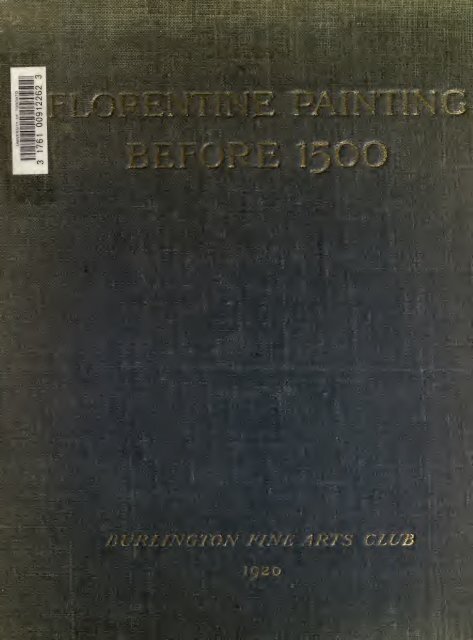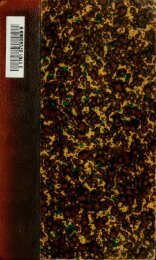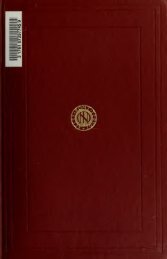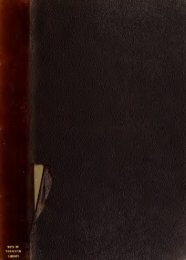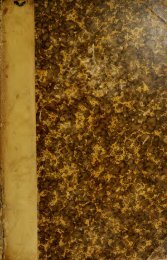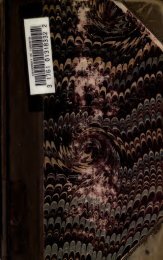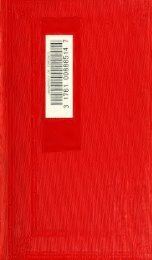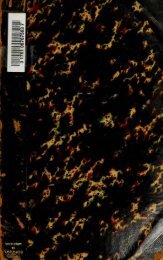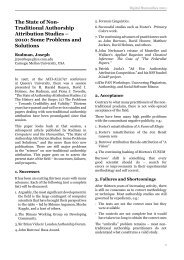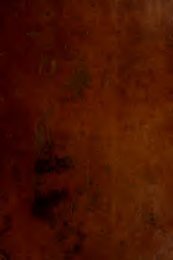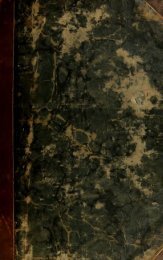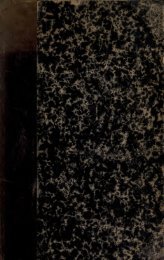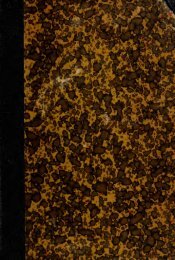Catalogue of an exhibition of Florentine painting ... - Warburg Institute
Catalogue of an exhibition of Florentine painting ... - Warburg Institute
Catalogue of an exhibition of Florentine painting ... - Warburg Institute
Create successful ePaper yourself
Turn your PDF publications into a flip-book with our unique Google optimized e-Paper software.
J *<br />
THE VIRGIN AND CHILD WITH ST. ANNE AND THE<br />
INFANT ST. JOHN THE BAPTIST<br />
LEONARDO DA VINCI
Burlington<br />
Fine Arts Club<br />
CATALOGUE OF AN EXHIBITION<br />
OF<br />
FLORENTINE PAINTING<br />
BEFORE 1500<br />
LONDON<br />
PRINTED FOR THE BURLINGTON FINE ARTS CLUB<br />
1920
CHISWICK PRESS: CHARLES WHITTINGHAM AND GRIGGS (PRINTERS), LTD.<br />
TOOKS COURT, CHANCERY LANE, LONDON.
COMMITTEE FOR THIS EXHIBITION<br />
DR. TANCRED BORENIUS.<br />
H. CLIFFORD-SMITH, ESQ.<br />
HERBERT F. COOK, ESQ.<br />
ROGER E. FRY, ESQ.<br />
HENRY HARRIS, ESQ.<br />
ROBERT C. WITT, ESQ., C.B.E.
LIST OF CONTRIBUTORS<br />
HIS MAJESTY THE KING.<br />
THE PRESIDENT AND COUNCIL OF THE ROYAL ACADEMY.<br />
THE MARQUESS OF BATH, K. G.<br />
*ROBERT H. BENSON, ESQ.<br />
Louis BREITMEYER, ESQ.<br />
*THE EARL BROWNLOW, P.C.<br />
J.<br />
ANNAN BRYCE, ESQ.<br />
* LORD CARMICHAEL OF SKIRLING, G. C.S.I., G.C.I. E., K.C.M.G.<br />
*W. B. CHAMBERLIN, ESQ.<br />
*H. CLIFFORD-SMITH, ESQ.<br />
SIR FREDERICK COOK, BT.<br />
*HERBERT F. COOK, ESQ.<br />
CAPTAIN R. LANGTON DOUGLAS.<br />
*ROGER E. FRY, ESQ.<br />
THE CORPORATION OF GLASGOW.<br />
*HENRY HARRIS, ESQ.<br />
J. P. HESELTINE, ESQ.<br />
*LT.-CoL. SIR GEORGE HOLFORD, K.C.V.O., C.I.E.<br />
NATIONAL GALLERY OF IRELAND.<br />
LADY JEKYLL.<br />
*VISCOUNT LASCELLES, D.S.O.<br />
MAJOR W. L. LUCAS.<br />
J. SEYMOUR LUCAS, R.A.<br />
*LT.~COLONEL L. C. R. MESSEL.<br />
*RT. HON. SIR ALFRED MONO, BT., M.P.<br />
*HENRY OPPENHEIMER, ESQ.<br />
MRS. HENRY OPPENHEIMER.<br />
UNIVERSITY OF OXFORD, ASHMOLEAN MUSEUM.
LIST OF CONTRIBUTORS<br />
UNIVERSITY OF OXFORD, CHRIST CHURCH.<br />
C. RICKETTS, ESQ.<br />
C. SHANNON, ESQ., A. R.A.<br />
*CAPTAIN E. G. SPENCER-CHURCHILL.<br />
REV. CANON J.<br />
O. STEPHENS.<br />
RT. HON. THE LADY WANTAGE.<br />
VERNON WATNEY, ESQ.<br />
*ROBERT C. WITT, ESQ., C.B.E.<br />
*W. H. WOODWARD, ESQ.<br />
* Contributors whose names are thus marked are members <strong>of</strong> the Club.
THE ART OF FLORENCE<br />
HE "artistic temperament" as used in the press <strong>an</strong>d<br />
the police-court these words betray a general misunderst<strong>an</strong>ding<br />
<strong>of</strong> the nature <strong>of</strong> art, <strong>an</strong>d <strong>of</strong> the artist whenever<br />
he becomes fully conscious <strong>of</strong> its purpose. The idea <strong>of</strong><br />
the artist as the plaything <strong>of</strong> whim <strong>an</strong>d caprice, a hypersensitive<br />
<strong>an</strong>d incoherent emotionalist, is, no doubt, true <strong>of</strong> a certain class<br />
<strong>of</strong> men, m<strong>an</strong>y <strong>of</strong> whom practise the arts;<br />
nothing could be further from a<br />
true account <strong>of</strong> those artists whose work has had the deepest influence on<br />
the tradition <strong>of</strong> art ; nothing could be less true <strong>of</strong> the great artists <strong>of</strong> the<br />
<strong>Florentine</strong> School.<br />
From the rise <strong>of</strong> modern art in the thirteenth century<br />
till now<br />
Florence <strong>an</strong>d Fr<strong>an</strong>ce have been the decisive factors in the art <strong>of</strong> Europe.<br />
Without them our art might have reflected innumerable pathetic or<br />
dramatic moods, it might have illustrated various curious or moving<br />
situations, it would not have attained to the conception <strong>of</strong> generalized<br />
truth <strong>of</strong> form.<br />
To Florence <strong>of</strong> the fourteenth <strong>an</strong>d fifteenth centuries <strong>an</strong>d to Fr<strong>an</strong>ce <strong>of</strong><br />
the seventeenth <strong>an</strong>d succeeding centuries we owe the creation <strong>of</strong> generalized<br />
or what, for w<strong>an</strong>t <strong>of</strong> a better word, we may call<br />
" intellectual " art.<br />
The word intellectual applied to art has so ugly<br />
a sound that it c<strong>an</strong><br />
only be admitted under the reserve <strong>of</strong> some attempted expl<strong>an</strong>ation.<br />
In<br />
7
8 THE ART OF FLORENCE<br />
science, where the intellect is allowed to be supreme, we c<strong>an</strong> distinguish two<br />
aspects <strong>of</strong> its activity, as has lately been pointed out by the author <strong>of</strong> <strong>an</strong><br />
illuminating<br />
" article, The Place <strong>of</strong> Science," in The Athenaeum for<br />
nth April. Of these two aspects one derives its motive power from<br />
curiosity, <strong>an</strong>d this deals with particular facts. It is only when, through<br />
curiosity, m<strong>an</strong> has accumulated a mass <strong>of</strong> particular observations that<br />
the second intellectual activity m<strong>an</strong>ifests itself, <strong>an</strong>d in this the motive<br />
is the satisfaction which the mind gets from the contemplation<br />
<strong>of</strong> inevitable<br />
relations.<br />
To secure this end the utmost possible generalization<br />
is necessary.<br />
Now both <strong>of</strong> these aspects <strong>of</strong> the intellect have their counterparts in<br />
art. Curiosity impels the artist to the consideration <strong>of</strong> every possible<br />
form in nature : under its stimulus he tends to accept<br />
each form in all its<br />
particularity as a given,<br />
unalterable fact. The other kind <strong>of</strong> intellectual<br />
activity impels the artist to attempt the reduction <strong>of</strong> all forms, as it were,<br />
to some common denominator which will make them comparable with<br />
one <strong>an</strong>other. It impels him to discover some aesthetically intelligible<br />
principle in various forms <strong>an</strong>d even to envisage the possibility<br />
<strong>of</strong> some<br />
kind <strong>of</strong> abstract form in the aesthetic contemplation <strong>of</strong> which the mind<br />
would attain satisfaction a satisfaction curiously parallel to that which<br />
the mind gets from the intellectual recognition<br />
<strong>of</strong> abstract truth.<br />
If we consider the effects <strong>of</strong> these two kinds <strong>of</strong> intellectual activity,<br />
or rather their exact <strong>an</strong>alogues, in art, we have to note that in so far as<br />
the artist's curiosity remains a purely intellectual curiosity<br />
it interferes<br />
with the perfection <strong>an</strong>d purity <strong>of</strong> the work <strong>of</strong> art by introducing<br />
<strong>an</strong> alien<br />
<strong>an</strong>d non-aesthetic element <strong>an</strong>d appealing to non-aesthetic desires; in so far<br />
as it<br />
merely supplies<br />
the artist with new motives <strong>an</strong>d a richer material<br />
out <strong>of</strong> which to build his designs, it is useful but subsidiary. Thus the<br />
objection to a ''subject picture," in so far as one remains conscious <strong>of</strong><br />
the subject as something outside <strong>of</strong>, <strong>an</strong>d apart from, the form, is a valid<br />
objection to the intrusion <strong>of</strong> intellect, <strong>of</strong> however rudimentary a kind,
THE ART OF FLORENCE 9<br />
into <strong>an</strong> aesthetic whole. The ordinary historical pictures <strong>of</strong> our <strong>an</strong>nual<br />
shows will furnish perfect examples <strong>of</strong> such <strong>an</strong> intrusion, since they<br />
exhibit innumerable appeals to intellectual recognitions<br />
without which<br />
the pictures would be me<strong>an</strong>ingless.<br />
Without some previous knowledge <strong>of</strong><br />
Caligula or Mary Queen <strong>of</strong> Scots we are likely to miss our way in a<br />
great deal <strong>of</strong> what passes for art to-day.<br />
The case <strong>of</strong> the generalizing intellect, or rather its<br />
<strong>an</strong>alogue,<br />
in art is<br />
more difficult.<br />
Here the recognition <strong>of</strong> relations is immediate <strong>an</strong>d sensational<br />
perhaps we ought to consider it as curiously<br />
akin to those cases<br />
<strong>of</strong> mathematical geniuses who have immediate intuition <strong>of</strong> mathematical<br />
relations which it is<br />
beyond their powers to prove so that it is<br />
by <strong>an</strong>alogy<br />
that we may talk <strong>of</strong> it at all as intellectual. But the <strong>an</strong>alogy<br />
is so close<br />
that I<br />
hope it may justify the use I here suggest.<br />
For in both cases the<br />
utmost possible generalization<br />
is aimed at, <strong>an</strong>d in both the mind is held<br />
in delighted equilibrium by the contemplation<br />
<strong>of</strong> the inevitable relations<br />
<strong>of</strong> all the parts in the whole, so that no need exists to make reference<br />
to what is outside the unity, <strong>an</strong>d this becomes for the time being a<br />
universe.<br />
It is then to such a generalizing idea <strong>of</strong> a work <strong>of</strong> art that the word<br />
intellectual is here applied.<br />
It is a curious fact that at the beginning <strong>of</strong> the fifteenth century in<br />
Italy, art was deeply affected by both kinds <strong>of</strong> intellectual activity.<br />
Curiosity about natural forms in all their variety <strong>an</strong>d complexity<br />
naturalism in the modern sense first m<strong>an</strong>ifested itself in Europe<strong>an</strong> art<br />
in Fl<strong>an</strong>ders, Fr<strong>an</strong>ce, <strong>an</strong>d North Italy about the second decade <strong>of</strong> the<br />
fifteenth century. It appears that Italy actually led the way<br />
in this<br />
movement, <strong>an</strong>d that Lombardy was the point <strong>of</strong> origin. Pis<strong>an</strong>ello <strong>an</strong>d<br />
Jacopo Bellini are the great exemplars in Italy <strong>of</strong> this idea <strong>of</strong> exploring<br />
indefatigably <strong>an</strong>d somewhat recklessly all those detailed aspects <strong>of</strong> nature<br />
which their predecessors, occupied in the gr<strong>an</strong>d Giottesque style, had<br />
scorned to notice.<br />
B
io<br />
THE ART OF FLORENCE<br />
In Florence, too, this impulse was undoubtedly felt,<br />
but it is the great<br />
distinction <strong>of</strong> the <strong>Florentine</strong> artists that, however much their curiosity<br />
about particular forms may have been excited, their high intellectual<br />
passion for abstract ideas impelled them more to the study<br />
<strong>of</strong> some<br />
general principles underlying all appear<strong>an</strong>ce. They<br />
refused to admit the<br />
given facts <strong>of</strong> nature except in so far as they<br />
could become amenable to<br />
the generalizing power <strong>of</strong> their art. Facts had to be digested into form<br />
before they were allowed into the system.<br />
We c<strong>an</strong> get <strong>an</strong> idea <strong>of</strong> what Florence <strong>of</strong> the fifteenth century me<strong>an</strong>t<br />
for the subsequent tradition <strong>of</strong> Europe<strong>an</strong><br />
art if we consider that if it had<br />
not been for Florence the art <strong>of</strong> Italy might have been not altogether<br />
unlike the art <strong>of</strong> Fl<strong>an</strong>ders <strong>an</strong>d the Rhine<br />
a little more rhythmical, a little<br />
more gracious, perhaps, but fundamentally hardly more signific<strong>an</strong>t.<br />
Although this typically <strong>Florentine</strong> attitude defined itself most clearly<br />
under the stress <strong>of</strong> naturalism it<br />
was, <strong>of</strong> course, already<br />
characteristic <strong>of</strong><br />
earlier <strong>Florentine</strong> art. Giotto, indeed, had left the tradition <strong>of</strong> formal<br />
completeness so firmly<br />
fixed in Florence that whatever new material had<br />
to be introduced it could only be introduced into a clearly recognized<br />
system <strong>of</strong> design.<br />
Of Giotto's own work we rarely get a sight in<br />
Engl<strong>an</strong>d,<br />
the National<br />
Gallery having missed the one great ch<strong>an</strong>ce <strong>of</strong> getting him represented<br />
some twenty years ago.<br />
But though Lady Jekyll's single figure <strong>of</strong> Christ<br />
c<strong>an</strong> by its nature give no idea <strong>of</strong> his amazing <strong>an</strong>d almost unequalled<br />
power <strong>of</strong> discovering unexpected inevitabilities <strong>of</strong> formal relations, it gives<br />
none the less something <strong>of</strong> Giotto's peculiar<br />
beauty <strong>of</strong> drawing, wherein<br />
the completest reality is attained without <strong>an</strong>y attempted verisimilitude.<br />
In Mr. Harris's Bernardo Daddi we get nearer perhaps<br />
to Giotto as a<br />
composer, <strong>an</strong>d even in his Giov<strong>an</strong>ni da Mil<strong>an</strong>o, in spite<br />
<strong>of</strong> some Lombard<br />
grossness <strong>an</strong>d sentimentality, the great<br />
tradition still lives.<br />
Masaccio, represented here by Mr. Rickett's single figure,<br />
is one <strong>of</strong><br />
the most mysterious personalities in art, <strong>an</strong>d typically <strong>Florentine</strong>. His
THE ART OF FLORENCE 11<br />
mystery lies partly in our ignor<strong>an</strong>ce about him, partly in the difficulty <strong>of</strong><br />
grasping the rapidity <strong>of</strong> action, the precocity, <strong>of</strong> genius such as his.<br />
Coming at the very beginning <strong>of</strong> the naturalistic movement he seized<br />
with a str<strong>an</strong>ge complacency <strong>an</strong>d ease upon the new material it <strong>of</strong>fered,<br />
but (<strong>an</strong>d this is what astounds one) he inst<strong>an</strong>tly discovered how to<br />
assimilate it perfectly to the formal requirements <strong>of</strong> design. So that not<br />
only the discovery <strong>of</strong> the new material, but its digestion<br />
was with him a<br />
simult<strong>an</strong>eous <strong>an</strong>d almost inst<strong>an</strong>t<strong>an</strong>eous process.<br />
He was helped perhaps<br />
by the fact that the new naturalism was as yet only a general perception<br />
<strong>of</strong> new aspects <strong>of</strong> natural form. It was left for his younger contemporaries<br />
to map out the new country methodically to the group <strong>of</strong><br />
ad venturous spirits Brunelleschi, Donatello, Castagno,<strong>an</strong>d Uccello who<br />
founded modern science, <strong>an</strong>d gave to the underst<strong>an</strong>ding<br />
<strong>of</strong> classic art<br />
a<br />
methodical basis. It is in this group that the fierce intellectual passion<br />
<strong>of</strong> the <strong>Florentine</strong> genius m<strong>an</strong>ifests itself most clearly.<br />
<strong>an</strong>atomy were the two studies which promised<br />
Perspective <strong>an</strong>d<br />
to reveal to them the<br />
secrets <strong>of</strong> natural form. The study <strong>of</strong> <strong>an</strong>atomy exemplifies mainly the<br />
aspect <strong>of</strong> curiosity, though even in this the desire to find the underlying<br />
principles <strong>of</strong> appear<strong>an</strong>ce is evident on the other h<strong>an</strong>d perspective,<br />
to its first discoverers, appeared to promise<br />
verisimilitude, it may<br />
far more th<strong>an</strong> <strong>an</strong> aid to<br />
have seemed a visual revelation <strong>of</strong> the structure <strong>of</strong><br />
space <strong>an</strong>d through that a key to the construction <strong>of</strong> pictorial space.<br />
To our more penetrating study <strong>of</strong> aesthetic (for <strong>of</strong> all sciences, aesthetic<br />
has been the greatest laggard)<br />
it is evident that neither perspective nor<br />
<strong>an</strong>atomy have <strong>an</strong>y very immediate bearing upon art both <strong>of</strong> them are<br />
me<strong>an</strong>s <strong>of</strong> ascertaining facts, <strong>an</strong>d the question <strong>of</strong> art begins where the<br />
question <strong>of</strong> fact ends. But artists have always<br />
had to excite themselves<br />
with some kind <strong>of</strong> subsidiary intoxic<strong>an</strong>t, <strong>an</strong>d perspective <strong>an</strong>d <strong>an</strong>atomy,<br />
while they were still in their inf<strong>an</strong>cy, acted admirably as stimul<strong>an</strong>ts. That<br />
they have by now become, for most artists,<br />
the dreariest <strong>of</strong> sedatives may<br />
make it difficult to conceive this.<br />
But at all events in that first generation
12 THE ART OF FLORENCE<br />
they excited their devotees to <strong>an</strong> ardent search for abstract unity <strong>of</strong> design.<br />
And this excitement went on to the next generation as exemplified<br />
by<br />
the works <strong>of</strong> the Umbro <strong>Florentine</strong>s Piero della Fr<strong>an</strong>cesca <strong>an</strong>d<br />
Signorelli <strong>an</strong>d in Florence itself <strong>of</strong> Pollajuolo.<br />
But the scientific spirit<br />
once aroused was destined not to remain for<br />
long so stimulating <strong>an</strong>d helpful <strong>an</strong> assist<strong>an</strong>t to the creation <strong>of</strong> design.<br />
It<br />
was bound in the end to start trains <strong>of</strong> thought too complex<br />
<strong>an</strong>d too<br />
absorbing to occupy a subordinate place. Already<br />
in the r<strong>an</strong>k <strong>an</strong>d file <strong>of</strong><br />
<strong>Florentine</strong> artists, the Ghirl<strong>an</strong>dajos, Filippino Lippis, <strong>an</strong>d their kindred,<br />
mere curiosity naif literalism had undermined the tradition, so that<br />
towards the last quarter <strong>of</strong> the century hardly <strong>an</strong>y<br />
artist knew how to<br />
design intelligibly on the scale <strong>of</strong> a fresco, whereas the merest duffer <strong>of</strong><br />
the fourteenth century could be certain <strong>of</strong> the volumes <strong>an</strong>d qu<strong>an</strong>tities<br />
<strong>of</strong><br />
his divisions.<br />
But it is with Leonardo da Vinci that the higher aspects<br />
<strong>of</strong> the<br />
scientific spirit first came into conflict with art. Doubtless this conflict<br />
is not fundamental nor final, but only <strong>an</strong> apparent result <strong>of</strong> hum<strong>an</strong><br />
limitations ;<br />
but to one who, like Leonardo, first had a Pisgah prospect<br />
<strong>of</strong> that immense territory, to the exploration <strong>of</strong> which four centuries <strong>of</strong><br />
the intensest hum<strong>an</strong> effort have been devoted without yet getting in<br />
sight<br />
<strong>of</strong> its boundaries to such a m<strong>an</strong> it was almost inevitable that the<br />
scientific content <strong>of</strong> art should assume <strong>an</strong> undue signific<strong>an</strong>ce. Up till<br />
Leonardo one c<strong>an</strong> say that the process <strong>of</strong> digesting into aesthetic form<br />
the new found material<br />
had kept pace with observation, though already<br />
in Verrocchio there is a sign <strong>of</strong> yielding to the crude phenomenon.<br />
But<br />
with Leonardo himself the org<strong>an</strong>izing faculty begins to break down under<br />
the stress <strong>of</strong> new matter. Leonardo himself shared to the full the<br />
<strong>Florentine</strong> passion for abstraction, but it was inevitable that he should be<br />
dazzled <strong>an</strong>d fascinated by the vast prospects<br />
that opened<br />
before his intellectual<br />
gaze. It was inevitable that where such vast masses <strong>of</strong> new<br />
particulars revealed themselves to his curiosity their claim for investigation
THE ART OF FLORENCE 13<br />
should be the most insistent. Not but what Leonardo did recognize the<br />
necessity<br />
for his art <strong>of</strong> some restriction <strong>an</strong>d choice.<br />
had revealed to him the whole gamut <strong>of</strong> atmospheric<br />
became a material for design<br />
His keen observation<br />
colour which first<br />
under Monet <strong>an</strong>d his followers. But<br />
having described a picture which would exactly correspond to a French<br />
<strong>painting</strong> <strong>of</strong> 1870, he rejects the whole <strong>of</strong> this new material as unsuitable<br />
for art.<br />
But even his rejection was not really a recognition <strong>of</strong> the claims<br />
<strong>of</strong> form, but only, alas ! <strong>of</strong> <strong>an</strong>other scientific trend with which his mind<br />
had become possessed. It was his almost prophetic vision <strong>of</strong> the<br />
possibilities <strong>of</strong> psychology which determined more th<strong>an</strong> <strong>an</strong>ything<br />
else the<br />
lines <strong>of</strong> his work. In the end almost everything was subordinated to<br />
the idea <strong>of</strong> a kind <strong>of</strong> psychological illustration <strong>of</strong> dramatic themes <strong>an</strong><br />
illustration which was not to be arrived at by<br />
<strong>an</strong> instinctive reconstruction<br />
from within, but by deliberate <strong>an</strong>alytic<br />
observation. Now in so far as<br />
the movements <strong>of</strong> the soul could be interpreted by movements <strong>of</strong> the<br />
body as a whole, the new material might lend itself readily to plastic construction,<br />
but the minuter k<br />
<strong>an</strong>d even more psychologically signific<strong>an</strong>t movements<br />
<strong>of</strong> facial expression dem<strong>an</strong>ded a treatment which hardly worked<br />
for aesthetic unity.<br />
It involved a new use <strong>of</strong> light <strong>an</strong>d shade, which in itself<br />
tended to break down the fundamental divisions <strong>of</strong> design, though later<br />
on Caravaggio <strong>an</strong>d Rembr<strong>an</strong>dt m<strong>an</strong>aged, not very successfully, to pull<br />
it<br />
round so as to become the material for the basic rhythm. And in <strong>an</strong>y<br />
case the <strong>an</strong>alytic trend <strong>of</strong> Leonardo's mind became too much accentuated<br />
to allow <strong>of</strong> a successful synthesis. Michel<strong>an</strong>gelo, to some extent, <strong>an</strong>d<br />
Raphael still more, did, <strong>of</strong> course, do much to re-establish a system<br />
<strong>of</strong> design on <strong>an</strong> enlarged basis which would admit <strong>of</strong> some <strong>of</strong><br />
Leonardo's new content, but one might hazard the speculation that Europe<strong>an</strong><br />
art has hardly yet recovered from the shock which Leonardo's<br />
passion for psychological illustration delivered. Certainly literalism <strong>an</strong>d<br />
illustration have through all these centuries been pressing d<strong>an</strong>gers to<br />
art d<strong>an</strong>gers which it has been the harder to resist in that they allow
14 THE ART OF FLORENCE<br />
<strong>of</strong> <strong>an</strong> appeal to that vast public to whom the l<strong>an</strong>guage<br />
<strong>of</strong> form is<br />
me<strong>an</strong>ingless.<br />
In <strong>Florentine</strong> art, then, one may see at happy moments <strong>of</strong> equilibrium<br />
the supreme adv<strong>an</strong>tages<br />
<strong>of</strong> intellectual art <strong>an</strong>d at other <strong>an</strong>d less fortunate<br />
moments the d<strong>an</strong>gers<br />
which beset so difficult <strong>an</strong> endeavour.<br />
all a <strong>Florentine</strong> who made the best prophecy<br />
It was after<br />
<strong>of</strong> the results <strong>of</strong> modern<br />
aesthetic when he said: " Finally good <strong>painting</strong> is a music <strong>an</strong>d a melody<br />
which intellect only c<strong>an</strong> appreciate <strong>an</strong>d that with difficulty."<br />
ROGER FRY.
CATALOGUE<br />
NOTE.<br />
TTie Pictures are numbered beginning on the left <strong>of</strong> the entr<strong>an</strong>ce door.<br />
The Committee accept no responsibility for the accuracy <strong>of</strong> the attributions in the<br />
<strong>Catalogue</strong>.<br />
1 ST. JAMES THE ELDER.<br />
PICTURES<br />
Three-quarter length <strong>of</strong> St. James the elder,<br />
green-blue m<strong>an</strong>tle, holding a pilgrim's staff in his<br />
book in his left.<br />
right<br />
in red robe <strong>an</strong>d<br />
h<strong>an</strong>d <strong>an</strong>d a<br />
P<strong>an</strong>el; 2<strong>of</strong> by 13 inches.<br />
GIOVANNI DA MILANO (fl. c. 1350).<br />
Lent by Mr. Henry Harris.<br />
2 SALVATOR MUNDI.<br />
Half-length <strong>of</strong> Christ, in red robe, holding the Book <strong>of</strong> Life in<br />
His left h<strong>an</strong>d, <strong>an</strong>d raising His right in benediction. Gold nimbus,<br />
with patterned cross <strong>an</strong>d gold background. The composition enclosed<br />
within a quatrefoil composed <strong>of</strong> a diamond with truncated<br />
base <strong>an</strong>d surrounded by circle.<br />
P<strong>an</strong>el, circular; 32 by 34 inches.<br />
Purchased in Florence in 1876 by<br />
Mr. Wm. Graham.<br />
See Roger Fry in The Burlington Magazine, vol. xx (November<br />
1911), p. 66.<br />
Exhibited at the Grafton Galleries Exhibition <strong>of</strong> Old Masters,<br />
1911, No. 3.<br />
GIOTTO (<br />
1 2 76- 1 336).<br />
Lent by Lady Jekyll.<br />
'5
16 PICTURES<br />
3 SCENES FROM THE STORY OF SALADIN AND<br />
TORELLO.<br />
falconer.<br />
(1) Sult<strong>an</strong> Saladin recognizes Torello, who has been made his<br />
(2) Torello is tr<strong>an</strong>sported miraculously in a bed to Pavia, <strong>an</strong>d<br />
is discovered by<br />
d'Oro, Pavia.<br />
the monks in the Church <strong>of</strong> S<strong>an</strong> Piero in Ciel<br />
(3) Torello's wife recognizes<br />
wedding feast by the ring dropped in a cup.<br />
him in the middle <strong>of</strong> her second<br />
P<strong>an</strong>el; i8f by 51^ inches.<br />
Front <strong>of</strong> a cassone, which doubtless originally was the comp<strong>an</strong>ion<br />
piece to one executed in <strong>an</strong> identical style <strong>an</strong>d illustrating<br />
other incidents <strong>of</strong> the story <strong>of</strong> Saladin, as related by Boccaccio in<br />
the Decameron, now in the Bargello at Florence. See G. de Nicola<br />
in The Burlington Magazine,<br />
vol. xxxii, May 1918, pp. ibgsgq.<br />
FLORENTINE SCHOOL, c. 1400. Lent by Mr. Henry Harris.<br />
4 THE CRUCIFIXION.<br />
In the centre <strong>of</strong> the composition Christ is nailed to the Cross,<br />
down which blood is trickling from the Saviour's wounds. On the<br />
left <strong>of</strong> the Cross st<strong>an</strong>ds the Virgin, <strong>an</strong>d on the right St. John. Gold<br />
tooled background.<br />
P<strong>an</strong>el, pointed above; 29^ by 13^ inches; in the gable a small<br />
half-length <strong>of</strong> Christ in the act <strong>of</strong> blessing.<br />
BERNARDO DADDI (d. 1350). Lent by Mr. Henry Harris.<br />
5 GOD THE FATHER.<br />
Half length <strong>of</strong> God the Father,<br />
in red robe <strong>an</strong>d blue m<strong>an</strong>tle<br />
with the right h<strong>an</strong>d raised in benediction, <strong>an</strong>d a globe in the left<br />
Gold background.<br />
Possibly once the top piece <strong>of</strong> the Naples Crucifixion.<br />
P<strong>an</strong>el, circular;<br />
diameter, 4 inches.<br />
MASACCIO (1401-1428).<br />
Lent by Mr. C. Ricketts <strong>an</strong>d Mr. C. Sh<strong>an</strong>non, A.R.A.
6 TWO ANGELS MAKING MUSIC.<br />
PICTURES 17<br />
Two <strong>an</strong>gels facing each other; one is seated, playing the harp,<br />
the other kneels <strong>an</strong>d plays <strong>an</strong> org<strong>an</strong>.<br />
Floor <strong>of</strong> red <strong>an</strong>d gold brocade <strong>an</strong>d background <strong>of</strong> gold.<br />
P<strong>an</strong>el; i8 by<br />
28 inches.<br />
From the Bohn Collection (1885), where it<br />
passed under the<br />
name <strong>of</strong> Orcagna. Subsequently attributed to a scholar <strong>of</strong> Lorenzo<br />
Monaco, <strong>an</strong>d probably by the scholar known as il Maestro del<br />
bambino vispo, now identified by Pr<strong>of</strong>essor Sire"n as Parri Spinelli<br />
(see The Burlington Magazine, March <strong>an</strong>d April, 1914).<br />
See T. Borenius in The Burlington Magazine, February, 1914.<br />
IL MAESTRO DEL BAMBINO VISPO. Lent by Mr. R. H. Benson.<br />
7 THE VIRGIN AND CHILD.<br />
Three-quarter length <strong>of</strong> the Virgin, who wears a rose robe, a<br />
blue m<strong>an</strong>tle, <strong>an</strong>d a white headcloth, <strong>an</strong>d st<strong>an</strong>ds in front <strong>of</strong> a<br />
window, holding in her arms the Inf<strong>an</strong>t Christ, who is dressed in<br />
white <strong>an</strong>d rose, <strong>an</strong>d kisses a bird which He holds in His left h<strong>an</strong>d.<br />
Gold tooled nimbi.<br />
P<strong>an</strong>el, rounded above; 28 by 22^ inches.<br />
Berenson, <strong>Florentine</strong> Painters, p. 150.<br />
FRA FILIPPO LIPPI (1406-1469). Lent by Earl Brownlow.<br />
8 CHRIST, THE ANGEL OF THE ANNUNCIATION, AND<br />
THE VIRGIN.<br />
Central compartment :<br />
Christ, in<br />
Christ.<br />
pale pink tunic <strong>an</strong>d blue m<strong>an</strong>tle lined with green, is<br />
st<strong>an</strong>ding on a cloud full face, raising His right h<strong>an</strong>d in benediction,<br />
<strong>an</strong>d holding<br />
in His left <strong>an</strong> open book inscribed in Gothic capitals:<br />
EGO SUM VIA VERITAS & VITA. Gold background.<br />
On the frame, below, the inscription: EGO SUM VIA VIA [sic]<br />
VERIT.<br />
Left compartment: The Angel <strong>of</strong> the Annunciation.<br />
The <strong>an</strong>gel, in cream-coloured under-habit, blue <strong>an</strong>d gold overc
i8<br />
PICTURES<br />
habit <strong>an</strong>d a pink m<strong>an</strong>tle lined with blue, with large red, brown, <strong>an</strong>d<br />
gold wings, is kneeling on a red <strong>an</strong>d gold carpet, holding a spray <strong>of</strong><br />
lilies in his left h<strong>an</strong>d <strong>an</strong>d raising his right in greeting. Gold background.<br />
On the frame, below, the inscription<br />
:<br />
AVE MARIA GRATIA PLE.<br />
Right compartment The Virgin.<br />
:<br />
The Virgin, in pink robe, blue m<strong>an</strong>tle lined with green <strong>an</strong>d gold<br />
embroideries, <strong>an</strong>d a white head-cloth, is seated on a low marble bench<br />
relieved against a rich red <strong>an</strong>d gold h<strong>an</strong>ging spread over a pink<br />
marble wall. Her left h<strong>an</strong>d rests on <strong>an</strong> open book, <strong>an</strong>d her right<br />
is<br />
pressed<br />
to her heart. To the left the dove descends. Gold background.<br />
On the frame, below, the inscription<br />
:<br />
ECCE ANCILLA DNI FIA.<br />
All p<strong>an</strong>els, with tops in the shape <strong>of</strong> pointed arches, 26^ by<br />
12 inches (0.67 mm. by 0.30 mm.).<br />
The frames are in one piece with the pictures, <strong>an</strong>d end in<br />
pointed gables, each containing a red seraph in a lozenge. On the<br />
back <strong>of</strong> each p<strong>an</strong>el <strong>an</strong> old tablet with the name Lorenzo degli Angeli<br />
<strong>an</strong>d the Nos. 48, 49, 50.<br />
Exhibited at the Grafton Galleries, Exhibition <strong>of</strong> Old Masters,<br />
1911, Nos. 19, 20, <strong>an</strong>d 22.<br />
AGNOLO GADDI (c. 1350-1396). Lent by Mr. Herbert Cook.<br />
g THE JUDGMENT OF PARIS.<br />
Small full-length figures <strong>of</strong> Paris <strong>an</strong>d the three goddesses.<br />
the left, Paris, fair-haired, in dark blue jerkin, red hose, yellow<br />
buskins, <strong>an</strong>d yellow cloak, is seated in pr<strong>of</strong>ile on a rock, a staff in<br />
his right h<strong>an</strong>d, <strong>an</strong>d gives the apple to Venus, behind whom st<strong>an</strong>d<br />
Juno <strong>an</strong>d Minerva. The three goddesses have golden hair, <strong>an</strong>d<br />
almost invisible scarves <strong>of</strong> tr<strong>an</strong>sparent white drapery. Their figures,<br />
tall <strong>an</strong>d slender, are relieved against a background <strong>of</strong> dark foliage.<br />
On<br />
In the left<br />
background is a rocky conical hill,<br />
seen against a horizon,<br />
flushed with evening light.<br />
By some contemporary <strong>of</strong> Pesellino as yet unidentified.<br />
P<strong>an</strong>el 16 ; by 19^ inches.
PICTURES 19<br />
From the collections <strong>of</strong> M. Bonaffe, Paris, <strong>an</strong>d Sir T. Gibson<br />
Carmichael, Bart. (1902).<br />
Exhibited at Burlington House, 1910.<br />
FLORENTINE SCHOOL, c. 1450. Lent by Mr. R. H. Benson.<br />
10 PIETA.<br />
The body <strong>of</strong> Christ is supported in the tomb by Joseph <strong>of</strong><br />
Arimathaea, who looks over His shoulder, wearing a crimson robe<br />
<strong>an</strong>d blue turb<strong>an</strong>. On either side are two <strong>an</strong>gels clad in dark blue,<br />
<strong>an</strong>d holding the raiment <strong>of</strong> Christ; one has the Crown <strong>of</strong> Thorns<br />
<strong>an</strong>d the other the Nails. The figures are relieved against a dark<br />
cavern in the rock.<br />
P<strong>an</strong>el ;<br />
6 by 13 inches.<br />
The drawing for this picture, pricked for use upon the gesso,<br />
formerly in the collection <strong>of</strong> the Earl <strong>of</strong> Pembroke at Wilton, now<br />
belongs to Mr. Henry Oppenheimer.<br />
Exhibited at the Burlington Club, 1902-3.<br />
Probably part <strong>of</strong> a predella.<br />
Exhibited at Burlington House R.A. Winter Exhibition, 1908.<br />
Bought at the Railway Station, Bologna.<br />
B. Berenson, <strong>Florentine</strong> Painters, p. 138.<br />
FILIPPINO LIPPI (1457-1504). Lent by Mr. R. H. Benson.<br />
II<br />
THE MARRIAGE OF THE VIRGIN.<br />
On the step <strong>of</strong> the Temple, in the centre, st<strong>an</strong>ds the High Priest,<br />
<strong>an</strong>d in front, on either side, Joseph <strong>an</strong>d Mary Virgin. Joseph's rod<br />
has blossomed <strong>an</strong>d a dove is<br />
seated thereon, <strong>an</strong>d he places a ring on<br />
Mary's finger. Behind her st<strong>an</strong>d two maidens <strong>an</strong>d a little boy; behind<br />
Joseph are five suitors breaking their barren rods, <strong>an</strong>d two trumpet<br />
blowers.<br />
ground.<br />
Composition <strong>of</strong> thirteen figures about 6 inches high on gold<br />
P<strong>an</strong>el;<br />
9 by 14^ inches.<br />
From the Bohn Collection (1885).<br />
Exhibited at Burlington House, 1887.<br />
AGNOLO GADDI (c. 1350-1396). Lent by Mr. R. H. Benson.
20 PICTURES<br />
12 THE VIRGIN AND CHILD WITH ST. JOHN.<br />
The Virgin, seated on a parapet which runs across the foreground<br />
<strong>an</strong>d is decorated with a frieze <strong>of</strong> nudes <strong>an</strong>d horses, holds the<br />
Inf<strong>an</strong>t Christ on her left knee <strong>an</strong>d bends forward a little towards the<br />
Inf<strong>an</strong>t St. John, who is<br />
kneeling with clasped h<strong>an</strong>ds in adoration <strong>of</strong><br />
the Holy Child. L<strong>an</strong>dscape background.<br />
P<strong>an</strong>el; 18 by 14^ inches.<br />
From the collection <strong>of</strong> Mr. Graham Charles Somerwell (1887).<br />
Exhibited at Burlington House in 1894 <strong>an</strong>d 1912.<br />
Home, Botticelli, p. 265.<br />
SANDRO BOTTICELLI (1444-1510).<br />
Lent by Mr. J. P. Heseltine.<br />
13 A MIRACLE OF SS. COSMAS AND DAMIAN.<br />
Interior <strong>of</strong> a room in which a m<strong>an</strong> is seen asleep in a large<br />
double bed, whilst SS. Cosmas <strong>an</strong>d Dami<strong>an</strong> who have just cut <strong>of</strong>f<br />
his leg, afflicted with c<strong>an</strong>cer, are replacing the diseased leg with<br />
one taken from a Moor lately buried. At the foot <strong>of</strong> the bed a<br />
wom<strong>an</strong> is seated on a stool, her face hidden in her h<strong>an</strong>ds.<br />
P<strong>an</strong>el ; 7f by 8f inches.<br />
From the collection <strong>of</strong> the Duke <strong>of</strong> Lucca (1840).<br />
Exhibited at the Worcestershire Exhibition in 1882.<br />
Arundel Club Portfolio, 1912, No. i.<br />
FRA ANGELICO (1387-1455).<br />
Lent by Capt, E. G. Spencer-Churchill.<br />
14 THE FALL OF SIMON MAGUS.<br />
On the left, Nero is seen, seated on his throne, on the far side<br />
<strong>of</strong> which a group <strong>of</strong> soldiers are st<strong>an</strong>ding,<br />
while on the near side is<br />
seen a pag<strong>an</strong> priest. On the right,<br />
in front <strong>of</strong> a group <strong>of</strong> onlookers,<br />
are seen St. Paul, kneeling in prayer, <strong>an</strong>d St. Peter, st<strong>an</strong>ding<br />
<strong>an</strong>d abjuring the evil spirits to desist from bearing to heaven Simon<br />
Magus, who has just taken his flight from a wooden stage or
PICTURES 21<br />
scaffold in the background. In the foreground lies the dead body <strong>of</strong><br />
Simon Magus, who has fallen face downwards to earth.<br />
P<strong>an</strong>el; 9^ by 13^ inches.<br />
From the Warner Ottley Collection, 1846.<br />
Part <strong>of</strong> the predella <strong>of</strong> the altar-piece, painted by Benozzo<br />
Gozzoli in 1461 for the confraternity <strong>of</strong> the Purification <strong>of</strong> the Virgin<br />
<strong>an</strong>d <strong>of</strong> S. Zenobius at Florence. The principal portion <strong>of</strong> this altarpiece<br />
is in the National Gallery (No. 283); <strong>of</strong> the other predella<br />
p<strong>an</strong>els, one was in the collection <strong>of</strong> the late M. Rodolphe K<strong>an</strong>n in<br />
Paris, <strong>an</strong>d is now in the Berlin Museum, <strong>an</strong>d <strong>an</strong>other is in the Brera<br />
Gallery at Mil<strong>an</strong>.<br />
See L. Cust <strong>an</strong>d Herbert Home in The Burlington Magazine,<br />
vol. viii,<br />
August 1905, pp. 377 sqq.<br />
BENOZZO GOZZOLI (1420-1497).<br />
Lent by H.M. The King.<br />
15 ST. JOSEPH AND ST. MICHAEL.<br />
St. Joseph <strong>an</strong>d St. Michael are seen kneeling in a walled<br />
enclosure <strong>of</strong> rose-coloured marble with a dark green cornice, <strong>an</strong>d the<br />
blue sky showing above the walls. St. Joseph is clad in a yellow<br />
tunic <strong>an</strong>d a purple-coloured m<strong>an</strong>tle edged with gold. St. Michael<br />
is represented in armour, with a blue sash <strong>an</strong>d pink m<strong>an</strong>tle, a red<br />
<strong>an</strong>d gold helmet on his head. In one h<strong>an</strong>d he holds his sword, in<br />
the other his white shield, with a red cross le<strong>an</strong>ing on the ground.<br />
The wings <strong>of</strong> St. Michael <strong>an</strong>d the nimbi are golden. Ground <strong>of</strong><br />
dark-green grass with flowers.<br />
Arched p<strong>an</strong>els, originally painted, each 32 by nf inches.<br />
Wings <strong>of</strong> a triptych painted in Florence by Fra Filippo for<br />
Giov<strong>an</strong>ni de' Medici, <strong>an</strong>d referred to in <strong>an</strong> autograph letter from the<br />
artist to his patron, dated 20 July 1457, <strong>an</strong>d preserved in the State<br />
Archives in Florence. Fra Filippo stated in this letter that the<br />
St. Michael is so far adv<strong>an</strong>ced as to require only the gold <strong>an</strong>d silver<br />
ornaments; promises to deliver the picture by 20 August <strong>of</strong> that<br />
year; asks for <strong>an</strong> honorarium <strong>of</strong> sixty florins, <strong>an</strong>d for <strong>an</strong> adv<strong>an</strong>ce.<br />
At the bottom <strong>of</strong> the sheet is a slight sketch <strong>of</strong> the whole triptych,<br />
in a frame <strong>of</strong> flamboy<strong>an</strong>t Gothic style, with the p<strong>an</strong>els ending in<br />
trefoil gables; the central compartment, now lost, represented the
22 PICTURES<br />
Virgin adoring- the Child, who is carried by two Angels. The artist<br />
did not, however, complete the work within the period mentioned<br />
by him this is proved by a letter from Fr<strong>an</strong>cesco C<strong>an</strong>tas<strong>an</strong>ti to<br />
:<br />
Giov<strong>an</strong>ni de' Medici, dated 31 August 1457, in which the writer<br />
says that he has been urging Fra Filippo on every day. The<br />
triptych was subsequently presented by Giov<strong>an</strong>ni de' Medici to<br />
Alfonso I <strong>of</strong> Aragon, King <strong>of</strong> Naples. On 27 May 1458, Giov<strong>an</strong>ni<br />
writes to Bartolomeo Serragli, his agent at Naples, acknowledging<br />
receipt <strong>of</strong> Serragli's letter, informing him that the Tavola had<br />
been presented to the King: <strong>an</strong>d it is referred to once more in a<br />
letter from Giov<strong>an</strong>ni to Serragli, dated 10 June 1458. These four<br />
documents are published in Mendelsohn, Fra Filippo Lippi, pp. 235-<br />
239 (compare also H. P. Home, Botticelli, pp. 7 sqq.), <strong>an</strong>d the letter<br />
<strong>of</strong> Fra Filippo is, moreover, reproduced in Mendelsohn, op. cit.,<br />
p. 156, <strong>an</strong>d Berenson, The Drawings <strong>of</strong> the <strong>Florentine</strong> Painters,<br />
Plate XXXIII.<br />
The two p<strong>an</strong>els in this <strong>exhibition</strong> were purchased at Madrid in<br />
1871 <strong>of</strong> the Condesa Pacheco, whose husb<strong>an</strong>d had been Sp<strong>an</strong>ish<br />
Ambassador in Rome.<br />
Exhibited at the Burlington Fine Arts Club, 1902,<br />
No. 16.<br />
Exhibited at the Grafton Galleries, National Lo<strong>an</strong> Exhibition,<br />
1909-10, No. 69.<br />
FRA FILIPPO LIPPI (1406-1469).<br />
Lent by Sir Frederick Cook, Bart.<br />
16 MADONNA AND CHILD UNDER A BALDACCHINO<br />
WITH ATTENDANT ANGELS.<br />
The Virgin wears a red tunic with gold ornaments, a blue goldedged<br />
m<strong>an</strong>tle, which also covers her head. Behind her <strong>an</strong> <strong>an</strong>gel,<br />
wearing a dark green dress, <strong>an</strong>d holding a blackbird, is<br />
peeping<br />
forth <strong>an</strong>d playing with the Inf<strong>an</strong>t Christ. Four <strong>an</strong>gels, dressed in<br />
various shades <strong>of</strong> red, support a gold baldacchino over the Virgin <strong>an</strong>d<br />
Child. Four other <strong>an</strong>gels in blue, red, <strong>an</strong>d yellow dresses surround<br />
the group. The nimbi <strong>an</strong>d the wings <strong>of</strong> the <strong>an</strong>gels are golden.<br />
Behind the figures a rose-hedge, over which the blue sky is seen.<br />
P<strong>an</strong>el; nj by 8^ inches (o.<br />
286mm. by 0.216 mm.).
PICTURES 23<br />
From the collections<br />
<strong>of</strong> Miss Rogers, Samuel Rogers the poet,<br />
<strong>an</strong>d Mr. C. Sackville Bale (as Benozzo Gozzoli).<br />
Exhibited at the British Institution in 1858 (No. 35) <strong>an</strong>d at<br />
Burlington House in 1870 (No. 118).<br />
Exhibited at this Club in 1902 (No. 15).<br />
Probably by <strong>an</strong> illuminator <strong>of</strong> the S<strong>an</strong> Marco school, in<br />
contact with Era Angelico.<br />
close<br />
School <strong>of</strong> ERA ANGELICO (1387-1455).<br />
Lent by Sir Frederick Cook, Bart.<br />
THE RAPE OF HELEN.<br />
The scene is laid near the Temple <strong>of</strong> Venus, which st<strong>an</strong>ds in a<br />
grove on the sea-shore. Paris, clad in blue tunic, red flowing m<strong>an</strong>tle<br />
lined with yellow, pink hose, dark boots, <strong>an</strong>d red turb<strong>an</strong>, is seen<br />
carrying Helen <strong>of</strong>f to a waiting boat: she wears a pink robe with a<br />
white fringe at the bottom <strong>of</strong> her dress <strong>an</strong>d round her red sleeves, a<br />
flower turb<strong>an</strong>, <strong>an</strong>d red pointed shoes. Near the shore is the ship,<br />
To the left the ladies<br />
on which is seen a m<strong>an</strong> in red cloak <strong>an</strong>d cap.<br />
in attend<strong>an</strong>ce are watching the rape in astonishment. They wear<br />
dresses <strong>of</strong> the fifteenth century (brown <strong>an</strong>d pink, green <strong>an</strong>d red), with<br />
the statue <strong>of</strong><br />
bright coloured turb<strong>an</strong>s. On the altar <strong>of</strong> the Temple<br />
Venus; on the cupola one <strong>of</strong> Cupid. Dark olive-green sea, with<br />
conventionalized waves. The isl<strong>an</strong>ds <strong>an</strong>d the dist<strong>an</strong>t shore are <strong>of</strong> a<br />
pale purple colour. Moonlit sky with clouds.<br />
P<strong>an</strong>el, dodecagonal ; diameter, 22^ inches. Painted on a desco da<br />
on which dishes were served to ladies in child-bed.<br />
parto or tray,<br />
Other deschi da parto painted by the same artist are in the<br />
Carr<strong>an</strong>d collection in the Bargello at Florence (No. 16) <strong>an</strong>d in the<br />
collection <strong>of</strong> M. Martin Le Roy <strong>of</strong> Paris;<br />
both are adorned with<br />
Paris. The author <strong>of</strong> these<br />
representations <strong>of</strong> the Judgement <strong>of</strong><br />
works is a purely <strong>Florentine</strong> painter <strong>of</strong> the same group as Pesellino.<br />
Exhibited at the Burlington Fine Arts Club Winter Exhibition,<br />
1902, No. 13.<br />
FLORENTINE SCHOOL, c. 1440.<br />
Lent by Sir Frederick Cook, Bart.
24 PICTURES<br />
18 SCENE FROM THE LEGEND OF SAINTS COSMAS AND<br />
DAMIAN.<br />
The two saints with their three brothers, Antimus, Leontius, <strong>an</strong>d<br />
Euprepius, are represented bound to a stake in the middle <strong>of</strong> the<br />
picture, surrounded with flames which, avoiding them, fly<br />
out <strong>an</strong>d<br />
catch the executioners who are kindling the fire. The Pro-Consul<br />
sits above on the judgement seat with other personages about him.<br />
P<strong>an</strong>el; 14 by 1 8 inches.<br />
Part <strong>of</strong> a predella formerly over the high altar <strong>of</strong> S<strong>an</strong> Marco <strong>of</strong><br />
Florence, described by Vasari "The : predella, in which are stories<br />
<strong>of</strong> the martyrdom <strong>of</strong> S<strong>an</strong> Cosimo, S<strong>an</strong> Dami<strong>an</strong>o, <strong>an</strong>d others, is so<br />
perfectly finished that one c<strong>an</strong>not imagine it possible for <strong>an</strong>ything to<br />
be executed with greater care, nor c<strong>an</strong> figures more delicate or more<br />
judiciously arr<strong>an</strong>ged be conceived." Of the seven p<strong>an</strong>els <strong>of</strong> which<br />
the predella was formed, the other six are identical with three in the<br />
Pinakothek at Munich (Nos. 989, 990, <strong>an</strong>d 991), two in the Accademia<br />
at Florence (Nos. 257 <strong>an</strong>d 258) where the main picture <strong>of</strong> the altarpiece<br />
also is preserved, <strong>an</strong>d one in the Louvre (No. 1293).<br />
The altar-piece was probably not begun before the early spring<br />
<strong>of</strong> 1439, as it shows reminiscences <strong>of</strong> the costumes <strong>of</strong> the members <strong>of</strong><br />
the Greek church, who visited Florence in J<strong>an</strong>uary <strong>an</strong>d February<br />
1439, attending the Council for the union <strong>of</strong> the churches. (See<br />
L. Douglas, Fra Angelica, pp. 86-91.)<br />
Exhibited at the Old Masters Exhibition at Burlington House in<br />
1877.<br />
Purchased at the sale <strong>of</strong> the collection <strong>of</strong> Mr. Wm. Graham in<br />
1886.<br />
Formerly in the collection <strong>of</strong> Signori<br />
Lombardi e Baldi in Florence,<br />
from whom Mr. Graham acquired<br />
it.<br />
FRA ANGELICO (1387-1455).<br />
Lent by the National Gallery <strong>of</strong> Irel<strong>an</strong>d.<br />
'"*><br />
19 THE VIRGIN AND THE CHILD WITH SAINTS.<br />
In the centre <strong>of</strong> the composition the Virgin, in pink robe <strong>an</strong>d<br />
blue m<strong>an</strong>tle, is enthroned, supporting with both h<strong>an</strong>ds the Inf<strong>an</strong>t<br />
Christ. Immediately on the left <strong>an</strong>d right <strong>of</strong> the Virgin<br />
is seen a
PICTURES 25<br />
youthful female saint; at the foot <strong>of</strong> the throne st<strong>an</strong>d, on the left,<br />
St. Anthony the Abbot <strong>an</strong>d St. Jerome, <strong>an</strong>d on the right, a sainted<br />
bishop <strong>an</strong>d St. George.<br />
P<strong>an</strong>el ; g^ by 8 inches.<br />
Crowe <strong>an</strong>d Cavalcaselle, History <strong>of</strong> Painting in Italy, ist<br />
ed., vol. ii; 2nd ed., vol. iv.<br />
W. Weisbach, Fr<strong>an</strong>cesco Pesellino, pp. 68 sqq.<br />
FRANCESCO PESELLINO (1422-1457).<br />
Lent by Lt.-Col. Sir George Holford, K.C. V.O., C.I.E.<br />
20 A KNIGHT.<br />
A knight in armour on horseback charging towards the left,<br />
br<strong>an</strong>dishing a sword with his right h<strong>an</strong>d. Background<br />
rocky hills.<br />
P<strong>an</strong>el;<br />
16 by 15! inches.<br />
Probably the end p<strong>an</strong>el <strong>of</strong> a cassone.<br />
<strong>of</strong> arid<br />
FLORENTINE SCHOOL, c. 1400. Lent by Mr. Henry Harris.<br />
21 THE ANNUNCIATION.<br />
Within a vaulted building the Virgin st<strong>an</strong>ds with head bowed<br />
down at the apparition <strong>of</strong> the Angel <strong>of</strong> the Annunciation, who<br />
comes flying towards her through a portico, beyond which is seen a<br />
l<strong>an</strong>dscape with hills. Rays <strong>of</strong> glory are also directed towards the<br />
Virgin.<br />
P<strong>an</strong>el; 19^ by 23 inches.<br />
From the MacLell<strong>an</strong> Collection.<br />
SANDRO BOTTICELLI (1444-1510).<br />
Lent by the Corporation <strong>of</strong> Glasgow.<br />
22 HUNT BY MOONLIGHT.<br />
The scene is laid in a forest,<br />
the oaks in which are beginning to<br />
turn brown, <strong>an</strong>d over which, in the centre, the crescent moon is<br />
silhouetted against the dark blue sky <strong>of</strong> night. A numecous hunting<br />
D
26 PICTURES<br />
party, with beaters-up <strong>an</strong>d greyhounds, are pursuing some stags<br />
which are making for the interior <strong>of</strong> the wood.<br />
P<strong>an</strong>el; 26^ by 67^ inches.<br />
Presented to the Ashmole<strong>an</strong> Museum by the Hon. W. T. H.<br />
Fox-Str<strong>an</strong>gways (subsequently fourth Earl <strong>of</strong> Ilchester) in 1850.<br />
A late work, closely allied in style to the predella <strong>of</strong> 1468 in the<br />
Gallery at Urbino.<br />
PAOLO UCCELLO (1397-1475)-<br />
Lent by the University <strong>of</strong> Oxford (Ashmole<strong>an</strong> Museum),<br />
23 PORTRAITS OF FRANCESCO SASSETTI AND HIS SON<br />
TEODORO.<br />
Three-quarter length figures slightly under life-size.<br />
Fr. Sassetti<br />
is seated facing, <strong>an</strong>d wears a purple skull cap <strong>an</strong>d red fur-lined gown<br />
fastened round the waist with a black cord, from which h<strong>an</strong>gs a<br />
pouch. His right h<strong>an</strong>d rests on the arm <strong>of</strong> his chair. His eyes look<br />
downward to his son, who st<strong>an</strong>ds on his left, in pr<strong>of</strong>ile, looking up,<br />
with clasped h<strong>an</strong>ds, <strong>an</strong>d wearing a dress <strong>of</strong> gray brocade trimmed<br />
with white fur, dark green slashed undersleeves, <strong>an</strong>d scarlet cap.<br />
Through a window behind is seen <strong>an</strong> inlet <strong>of</strong> the sea, with mountains<br />
<strong>an</strong>d buildings. Inscribed on the top <strong>of</strong> the window frame: FRAN-<br />
CISCVS SAXETTVS THEODORVSQVE.<br />
The outline <strong>of</strong> the cap exhibits a correction, diminishing<br />
the size <strong>of</strong> the head.<br />
it to<br />
Fr<strong>an</strong>cesco Sassetti, born about 1420, was partner <strong>of</strong> Lorenzo<br />
dei Medici in his b<strong>an</strong>k at Lyons, <strong>an</strong>d died in 1491. Teodoro was<br />
born ii March 1479, <strong>an</strong>d is depicted between eight <strong>an</strong>d ten years<br />
<strong>of</strong> age, which fixes the date <strong>of</strong> the picture as 1487-89. Teodoro was<br />
gr<strong>an</strong>dfather <strong>of</strong> Filippo Sassetti,<br />
well known for his travels in India<br />
(Marcucci, Letere di Filippo Sassetti, Firenze, 1855).<br />
P<strong>an</strong>el ; 29^ by 20^ inches.<br />
From the Graham Collection.<br />
1909-10.<br />
Exhibited at Burlington House, 1875 <strong>an</strong>d 1893.<br />
Exhibited at the New Gallery, 1893-4.<br />
Exhibited at the Grafton Galleries National Lo<strong>an</strong> Exhibition
PICTURES 27<br />
B. Berenson, <strong>Florentine</strong> Painters, p. 138.<br />
Crowe <strong>an</strong>d Cavalcaselle, Painting in Italy, ed. L. Douglas,<br />
vol. iv, p. 336, n. 5.<br />
DOMENICO GHIRLANDAJO (1449-1494).<br />
Lent by Mr. R. H. Benson.<br />
24 CHRIST AT THE COLUMN.<br />
Half-length <strong>of</strong> Christ, st<strong>an</strong>ding tied to a column, a white cloth<br />
round his hips. In the dist<strong>an</strong>t l<strong>an</strong>dscape are seen St. John the<br />
Baptist, St. Jerome doing pen<strong>an</strong>ce, Tobit <strong>an</strong>d the Angel,<br />
Fr<strong>an</strong>cis receiving the stigmata.<br />
P<strong>an</strong>el; 30 by 25 inches.<br />
From the collection <strong>of</strong> Robert Browning (1913)<br />
in Old Pictures in Florence, st<strong>an</strong>za xxviii :<br />
<strong>an</strong>d St.<br />
<strong>an</strong>d referred to<br />
Could not the ghost with the close red cap,<br />
My Pollajolo, the twice a craftsm<strong>an</strong>,<br />
Save me a sample, give me the hap<br />
Of a muscular Christ that shows the draughtsm<strong>an</strong>.<br />
School <strong>of</strong> ANTONIO DEL POLLAIUOLO (1429-1498).<br />
Lent by Viscount Lascelles, D.S.O.<br />
25 TOBIAS AND THE ANGEL.<br />
The arch<strong>an</strong>gel Raphael, with a pot <strong>of</strong> ointment in his right h<strong>an</strong>d,<br />
leads Tobias, who holds the fish in a string suspended from his left<br />
forefinger; the lights on their raiment heightened with gold. In front<br />
moves a small long-haired white dog. L<strong>an</strong>dscape with a lake, trees<br />
<strong>an</strong>d a tower to the right.<br />
One <strong>of</strong> a group <strong>of</strong> pictures which Mr. Berenson distinguishes<br />
from the rest <strong>of</strong> Filippino's work, provisionally naming the painter<br />
<strong>of</strong> them " Amico di S<strong>an</strong>dro."<br />
P<strong>an</strong>el ; I2| by 9^ inches.<br />
Exhibited at Burlington House, 1910.<br />
B. Berenson, <strong>Florentine</strong> Painters, p. 138.<br />
FILIPPINO LIPPI (1457-1504).<br />
Lent by Mr. R. H. Benson,
28 PICTURES<br />
26 THE ADORATION OF THE MAGI.<br />
The Virgin <strong>an</strong>d Child <strong>an</strong>d St.<br />
Joseph are seen in the foreground<br />
to the right, in front <strong>of</strong> a large ruined building, situated on the slope<br />
<strong>of</strong> a hill, down which the long winding procession <strong>of</strong> the Magi is<br />
moving. The Virgin, in pink tunic <strong>an</strong>d blue m<strong>an</strong>tle with green<br />
lining <strong>an</strong>d gold borders, is seated on a rock holding the Inf<strong>an</strong>t<br />
Christ, to whom the eldest king, dressed in very pale purple, is<br />
doing homage. Behind him kneel the two other kings, one crossing<br />
his h<strong>an</strong>ds in front <strong>of</strong> his breast, wearing a blue tunic <strong>an</strong>d a pale red<br />
under-habit, the other holding a vase, in scarlet tunic, also adorned<br />
with gold. All the kings wear jewelled b<strong>an</strong>ds on their heads.<br />
St. Joseph, who raises his right h<strong>an</strong>d in astonishment, wears a blue<br />
tunic <strong>an</strong>d head-dress <strong>an</strong>d <strong>an</strong> or<strong>an</strong>ge m<strong>an</strong>tle. A peacock<br />
is<br />
perched<br />
on the ro<strong>of</strong> <strong>of</strong> a stable in the middle dist<strong>an</strong>ce, <strong>an</strong>d two other birds<br />
are just in the act <strong>of</strong> flying down from it.<br />
Five boys, almost naked<br />
<strong>an</strong>d probably beggars, are seen to the left somewhat more towards<br />
the background climbing among the ruins, watching the procession.<br />
Dark blue sky. There is much variety in the colours <strong>of</strong> the costumes,<br />
reds, blues, <strong>an</strong>d yellows being the prevailing notes. The general<br />
tone is very light.<br />
P<strong>an</strong>el, circular; diameter, 54 inches.<br />
From the collection <strong>of</strong> Mr. Alex<strong>an</strong>der Barker (1879).<br />
Exhibited at Burlington House, Old Masters, 1875 (No. 184).<br />
Exhibited at the Grafton Galleries, National Lo<strong>an</strong> Exhibition,<br />
1909-10 (No. 68).<br />
Crowe <strong>an</strong>d Cavalcaselle, Itali<strong>an</strong> Painters, ist ed., vol. ii,<br />
p. 350; <strong>an</strong>d ed., vol. iv, pp. 175 sqq.<br />
This "incomparable piece <strong>of</strong> pure <strong>Florentine</strong> art" (Home) is<br />
probably the earliest ext<strong>an</strong>t work by Filippo Lippi (painted about<br />
1430), <strong>an</strong>d at the same time the earliest known example <strong>of</strong> the<br />
circular shape as used for a devotional picture a motive which<br />
subsequently became very popular, especially in <strong>Florentine</strong> <strong>painting</strong>.<br />
The conception <strong>of</strong> the subject is reminiscent <strong>of</strong> Gentile da Fabri<strong>an</strong>o's<br />
famous Adoration, now in the Florence Academy; certain figures<br />
<strong>an</strong>d notes <strong>of</strong> colour strongly recall Fra Angelico, other features<br />
again Masolino. In the harmony <strong>of</strong> the colouring,<br />
the wonderful
PICTURES 29<br />
treatment <strong>of</strong> the play <strong>of</strong> light, <strong>an</strong>d the original <strong>an</strong>d masterly composition,<br />
Fra Filippo gives striking evidence <strong>of</strong> his individual gifts.<br />
FRA FILIPPO LIPPI (1406-1469).<br />
Lent by Sir Frederick Cook, Bart.<br />
27 GROUP OF WOMEN.<br />
Composition <strong>of</strong> eight female figures, st<strong>an</strong>ding in a meadow.<br />
P<strong>an</strong>el; 12 by 9^ inches.<br />
From the Linnell Collection, 1918.<br />
Possibly once formed part <strong>of</strong> the decoration <strong>of</strong> the same cassone<br />
as the Combat bet-ween Amor <strong>an</strong>d Castitas in the National Gallery<br />
(No. 1196) <strong>an</strong>d The Triumph <strong>of</strong> Chastity in the Turin Gallery. The<br />
Turin picture was the central p<strong>an</strong>el ;<br />
<strong>an</strong> end piece ;<br />
the National Gallery p<strong>an</strong>el was<br />
<strong>an</strong>d although the present p<strong>an</strong>el<br />
is <strong>of</strong> smaller dimensions<br />
th<strong>an</strong> the National Gallery picture (i6f by i3f inches)<br />
it may yet be<br />
its comp<strong>an</strong>ion piece, since it shows evidence <strong>of</strong> having been cut down.<br />
See Roger Fry in The Burlington Magazine, vol. xxxii, May<br />
1918, p. 201.<br />
COSIMO ROSSELLI (1439-1507).<br />
Lent by Mr. W. B. Chamberlin.<br />
28 PORTRAIT OF AN ECCLESIASTIC.<br />
Half-length <strong>of</strong> <strong>an</strong> ecclesiastic, seated at a table covered with a<br />
brightly coloured cloth, making a pointing gesture with his right<br />
h<strong>an</strong>d <strong>an</strong>d resting his left on a book, st<strong>an</strong>ding on edge on the table.<br />
L<strong>an</strong>dscape background.<br />
P<strong>an</strong>el; 27^ by 20^ in.<br />
From the collection <strong>of</strong> the Earl <strong>of</strong> Malmesbury (1876).<br />
The names <strong>of</strong> both Raphael <strong>an</strong>d <strong>of</strong> Ridolfo Ghirl<strong>an</strong>dajo have in<br />
the past been associated with this picture (see The Burlington<br />
Magazine, vol. xxiii, May 1913, p. 65).<br />
PIERO DI COSIMO (1462-1521).<br />
Lent by Viscount Lascelles, D. S. O.
PICTURES<br />
29 CORONATION OF THE VIRGIN.<br />
In the glory above, which is encircled by white clouds <strong>an</strong>d<br />
guarded by four red-winged cherubim, Christ appears, enthroned on<br />
clouds, <strong>an</strong>d clothed in red with a deep blue m<strong>an</strong>tle. He is in the act <strong>of</strong><br />
placing the crown on the head <strong>of</strong> the Virgin, who kneels before Him,<br />
her h<strong>an</strong>ds crossed on her bosom. She wears a dark gray underdress,<br />
<strong>an</strong>d over it a long m<strong>an</strong>tle <strong>of</strong> white <strong>an</strong>d gold<br />
brocade with rose-coloured<br />
lining.<br />
Beneath are grouped four saints; on the left, St. Nicholas <strong>of</strong><br />
Bari, st<strong>an</strong>ding facing, in his episcopal green <strong>an</strong>d gold chasuble <strong>an</strong>d<br />
Bishop's mitre, holding his pastoral staff <strong>an</strong>d a book. Before him<br />
kneels St. Barbara, in pr<strong>of</strong>ile, in a blue robe <strong>an</strong>d scarlet m<strong>an</strong>tle,<br />
gazing upwards, <strong>an</strong>d carrying in her h<strong>an</strong>d the tower in which she<br />
was confined by her father until liberated by <strong>an</strong>gels. On the right<br />
st<strong>an</strong>ds St. Juli<strong>an</strong> <strong>of</strong> Rimini, three-quarter face to left, a fair-haired<br />
youth in a secular costume consisting <strong>of</strong> a gray tunic, rose-coloured<br />
m<strong>an</strong>tle, <strong>an</strong>d scarlet <strong>an</strong>d yellow buskins. Round his brow c<strong>an</strong> be<br />
discerned the rare attribute<br />
<strong>of</strong> the stigmata <strong>of</strong> the crown <strong>of</strong> thorns,<br />
faintly indicated by drops <strong>of</strong> blood. He holds a palm <strong>an</strong>d a book,<br />
<strong>an</strong>d looks down upon St. Christina, who kneels beside him in adoration,<br />
wearing a red dress <strong>an</strong>d dark gray m<strong>an</strong>tle, <strong>an</strong>d bearing her<br />
palm <strong>an</strong>d arrow.<br />
Background <strong>of</strong> a l<strong>an</strong>dscape in delicate blue <strong>an</strong>d green tints, with<br />
a fortified town on the slope <strong>of</strong> a dist<strong>an</strong>t hill, <strong>an</strong>d a delicately graduated<br />
clear blue sky.<br />
Below the picture is a small predella, with three figures: in the<br />
with his<br />
centre Christ seated in the tomb ;<br />
on the right St. Anthony<br />
lily <strong>an</strong>d book ;<br />
on the left St. Fr<strong>an</strong>cis <strong>of</strong> Assisi, indicating that the<br />
picture was painted for a Fr<strong>an</strong>cisc<strong>an</strong> Church or Chapel.<br />
P<strong>an</strong>el, circular top; 36 by 17! inches.<br />
From the collection <strong>of</strong> Samuel Rogers, who bought<br />
it in Rome.<br />
Exhibited at M<strong>an</strong>chester, Art Treasures Exhibition, 1857; Royal<br />
Academy, Old Masters, 1870; New Gallery, Early Itali<strong>an</strong> Art, 1893.<br />
Crowe <strong>an</strong>d Cavalcaselle, History <strong>of</strong> Painting in Italy, ist ed.,<br />
vol. iii, p. 414; 2nd ed., vol. vi, p. 41.<br />
LORENZO DI CREDI (1457-1537).<br />
Lent by Lady W<strong>an</strong>tage.
30 MINERVA AND THE FLUTE.<br />
Continuous composition in<br />
PICTURES 31<br />
a wooded <strong>an</strong>d rocky l<strong>an</strong>dscape with<br />
the sea in the dist<strong>an</strong>ce. On the extreme left is Minerva, who,<br />
disgusted at beholding in the waters <strong>of</strong> a brook her own reflection,<br />
with puffed-out cheeks, is<br />
throwing away two flutes on which she<br />
has been playing. Farther on the right are seen two satyrs, who<br />
have picked up the instruments.<br />
P<strong>an</strong>el; 27 by 61 inches.<br />
Arundel Club Portfolio, 1914, No. 2.<br />
PIERO DI COSIMO (1462-1521).<br />
Lent by Mrs, Henry Oppenheimer.<br />
31 BATTLE OF THE CENTAURS AND LAPITHAE.<br />
Composition <strong>of</strong> numerous figures in a rocky <strong>an</strong>d wooded l<strong>an</strong>dscape,<br />
with various incidents in the struggle between the Centaurs<br />
<strong>an</strong>d the Lapithae shown in the foreground <strong>an</strong>d middle dist<strong>an</strong>ce.<br />
P<strong>an</strong>el; 27f by 102 inches.<br />
See Home in the Architectural Review, 1902, pp. 61 sqq.<br />
PIERO DI COSIMO (1462-1521).<br />
Lent by Messrs. C. Ricketts <strong>an</strong>d C. Sh<strong>an</strong>non, A.R.A.<br />
32 THE MARRIAGE FEAST OF NASTAGIO DEGLI ONESTI<br />
WITH THE DAUGHTER OF PAOLO TRAVERSARI.<br />
The feast takes place in the open air under a loggia seen in the<br />
perspective <strong>of</strong> its length, <strong>an</strong>d enclosing two walls which extend<br />
between three rows <strong>of</strong> five piers, supporting semicircular arches.<br />
The guests are seated at two long, narrow tables, the women on the<br />
left <strong>an</strong>d the men on the right. Above the capitals <strong>of</strong> the three<br />
foremost piers <strong>of</strong> the loggia are three shields, <strong>of</strong> which the one on<br />
the left is blazoned with the arms <strong>of</strong> the Pucci; that on the left with<br />
Pucci impaling Bini ;<br />
<strong>an</strong>d the central one shows the Medici arms.<br />
Before the central pier is placed a sideboard covered with richly<br />
wrought plate. The bridegroom<br />
is seated by himself, in a wrought<br />
metal chair, at the women's table opposite the bride, to whom he
32 PICTURES<br />
<strong>of</strong>fers a bowl <strong>of</strong> wine. The last course <strong>of</strong> the b<strong>an</strong>quet is being<br />
brought to table by eight pages, four on each side.<br />
P<strong>an</strong>el ; 32 by 55 inches.<br />
This picture illustrates the final incident <strong>of</strong> Boccaccio's novel <strong>of</strong><br />
Nastagio degli Onesti. It is one <strong>of</strong> a set <strong>of</strong> four, painted to<br />
celebrate the marriage <strong>of</strong> Gi<strong>an</strong>nozzo Pucci with Lucrezia Bini in<br />
in the<br />
1483, <strong>an</strong>d referred to by Vasari. The whole set was formerly<br />
Alex<strong>an</strong>der Barker <strong>an</strong>d F. R. Leyl<strong>an</strong>d Collections; at present the<br />
p<strong>an</strong>els illustrating the three earlier incidents in the story belong to<br />
M. Spiridon <strong>of</strong> Paris.<br />
Home, Botticelli, pp. 126 sqq. ("all the four p<strong>an</strong>els were<br />
certainly designed by Botticelli himself, but their execution appears<br />
to have been almost entirely carried out by assist<strong>an</strong>ts ").<br />
SANDRO BOTTICELLI (1444-1510).<br />
Lent by Mr, Vernon Watney.<br />
33 STORY OF DAVID AND GOLIATH.<br />
Continuous composition <strong>of</strong> numerous figures in a l<strong>an</strong>dscape<br />
setting, containing a number <strong>of</strong> episodes from the early<br />
life <strong>of</strong> David :<br />
(i) In the upper left-h<strong>an</strong>d corner is a pastoral l<strong>an</strong>dscape, in<br />
which David appears as a fair-haired shepherd boy, wearing a dull<br />
pink tunic <strong>an</strong>d a darker rose-red cloak <strong>an</strong>d buskins, with bare head<br />
<strong>an</strong>d knees <strong>an</strong>d s<strong>an</strong>dalled feet (a costume which he preserves throughout<br />
this composition <strong>an</strong>d No. 34). He is seated on a b<strong>an</strong>k keeping<br />
watch over his herd <strong>of</strong> cattle <strong>an</strong>d flock <strong>of</strong> sheep. (2)<br />
Lower down<br />
David is seen bending over a brook <strong>an</strong>d selecting pebbles<br />
for his<br />
sling; two lions <strong>an</strong>d a lioness are watching him. (3) On the right<br />
<strong>of</strong> these incidents is seen King Saul, mounted on a white charger,<br />
<strong>an</strong>d surrounded by a number <strong>of</strong> horsemen. He looks down upon<br />
David, who st<strong>an</strong>ds behind him appealing against the fettering <strong>of</strong> his<br />
free limbs by shoulder-pieces <strong>an</strong>d greaves,<br />
girding on him. (4) The central subject<br />
which two attend<strong>an</strong>ts are<br />
is the battle between the<br />
Israelites <strong>an</strong>d the Philistines, raging fiercely, wounded <strong>an</strong>d dying<br />
men <strong>an</strong>d horses lying on the ground. (5) Farther on the right,<br />
David is seen slinging the stone against the forehead <strong>of</strong> Goliath, a<br />
huge figure in black <strong>an</strong>d gold coat <strong>of</strong> mail, <strong>an</strong>d holding a massive
PICTURES 33<br />
club. (6) On the left <strong>of</strong> the last scene, in the extreme foreground,<br />
David is seen severing the head from the prostrate body <strong>of</strong> Goliath.<br />
(7) On the extreme right the battle is continued in front <strong>of</strong> the tents<br />
<strong>of</strong> the enemy.<br />
P<strong>an</strong>el ; 17 by 70 inches.<br />
Front <strong>of</strong> a Cassone, formerly in the possession <strong>of</strong> the Pazzi<br />
family <strong>of</strong> Florence, <strong>an</strong>d subsequently in the Palazzo Torregi<strong>an</strong>i.<br />
Exhibited at Burlington House, Old Masters, 1902.<br />
Crowe <strong>an</strong>d Cavalcaselle, History <strong>of</strong> Painting in Italy, ist ed.,<br />
vol. ii, pp. 366-7.<br />
W. Weisbach, Fr<strong>an</strong>cesco Peselltno, pp. 84-90.<br />
FRANCESCO PESELLINO (1411-1457).<br />
Lent by Lady W<strong>an</strong>tage.<br />
34 THE TRIUMPH OF DAVID.<br />
Composition <strong>of</strong> numerous figures in a l<strong>an</strong>dscape setting. On<br />
the left is seen the Triumphal Car, on which st<strong>an</strong>ds David, with his<br />
sling in his left h<strong>an</strong>d <strong>an</strong>d the head <strong>of</strong> Goliath in his right. Behind<br />
him lies the decapitated body <strong>of</strong> the gi<strong>an</strong>t. On the right, four<br />
Philistine captives are seated on a car platform, possibly attached<br />
to the chariot <strong>of</strong> Saul, which precedes that <strong>of</strong> David ;<br />
<strong>an</strong>d both<br />
triumphal cars are preceded <strong>an</strong>d followed by a crowd <strong>of</strong> horsemen, <strong>an</strong>d<br />
men <strong>an</strong>d youths on foot: on the extreme right<br />
is a betrothal ceremony<br />
unconnected with the scriptural subject.<br />
P<strong>an</strong>el ; 17 by 70 inches.<br />
Comp<strong>an</strong>ion piece to No. 33. See the comments on that work.<br />
FRANCESCO PESELLINO (1411-1457). Lent by Lady W<strong>an</strong>tage.<br />
35 THE VIRGIN IN ADORATION.<br />
Three-quarter length <strong>of</strong> the Virgin turned three-quarters<br />
to the<br />
right, in scarlet robe <strong>an</strong>d blue m<strong>an</strong>tle both embroidered with gold,<br />
<strong>an</strong>d with a thin tr<strong>an</strong>sparent veil draped over her head. Her h<strong>an</strong>ds<br />
are joined in prayer. The scene is laid in a ruined building <strong>an</strong>d<br />
behind the Virgin on the right are seen the ox <strong>an</strong>d the ass.<br />
P<strong>an</strong>el; 26^ by 14 inches.<br />
From the collection <strong>of</strong> Mr. T. G. Arthur <strong>of</strong> Glasgow <strong>an</strong>d<br />
Carrick House, N.B.<br />
A fragment <strong>of</strong> a picture <strong>of</strong> the Nativity, closely associated with
34 PICTURES<br />
the Madonna with Angels in the National Gallery,<br />
No. 296,<br />
<strong>an</strong>d the<br />
Madonna which, from the collection <strong>of</strong> Mr. Charles Butler, passed<br />
into that <strong>of</strong> Mr. Benjamin Altm<strong>an</strong> <strong>an</strong>d is now in the Metropolit<strong>an</strong><br />
Museum <strong>of</strong> Art in New York.<br />
See T. Borenius in The Burlington Magazine, vol. xxx, April<br />
1917, p. 129.<br />
School <strong>of</strong> VERROCCHIO (1435-1488).<br />
Lent by Mr. W. H. Woodward.<br />
36 ST. JEROME.<br />
St. Jerome, sc<strong>an</strong>tily dressed in a white drapery, is seen kneeling<br />
in the foreground, doing pen<strong>an</strong>ce before a crucifix, which is attached<br />
to a tree, from the br<strong>an</strong>ches <strong>of</strong> which h<strong>an</strong>gs the saint's cardinal's<br />
hat. Before the saint are some books, one <strong>of</strong> them <strong>an</strong> open book <strong>of</strong><br />
prayer, <strong>an</strong>d a cardinal's cloak is thrown on a ledge<br />
<strong>of</strong> rock on the<br />
left. Behind the saint is seen the lion crouching on the ground.<br />
The scene is laid in front <strong>of</strong> a cave opening at the back towards a<br />
l<strong>an</strong>dscape.<br />
P<strong>an</strong>el, circular;<br />
diameter, 22| inches.<br />
Traditionally ascribed to ANDREA DEL CASTAGNO (d. 1457).<br />
Lent by the Marquess <strong>of</strong> Bath.<br />
37 ST. CATHERINE OF ALEXANDRIA.<br />
Full-length <strong>of</strong> St. Catherine <strong>of</strong> Alex<strong>an</strong>dria turned slightly to the<br />
left. She wears a scarlet robe <strong>an</strong>d a blue tunic, <strong>an</strong>d holds with both<br />
h<strong>an</strong>ds a half-open book; her left h<strong>an</strong>d holding at the same time the<br />
palm <strong>of</strong> martyrdom. In the foreground is seen a fragment <strong>of</strong> her<br />
emblematical wheel. L<strong>an</strong>dscape background with precipitous rocky<br />
hills bordering a plain.<br />
P<strong>an</strong>el; 34 by 14^ inches.<br />
See Roger Fry in The Burlington Magazine, vol. xxix,<br />
April 1916, p. 3. From the collection <strong>of</strong> the Earl <strong>of</strong> Northesk,<br />
19*5-<br />
BARTOLOMEO DI GIOVANNI (c. 1500).<br />
Lent by Mr. Henry Harris.
PICTURES 35<br />
38 MYTHOLOGICAL SCENE.<br />
A Centaur (Cheiron?) wounded in the foot by <strong>an</strong> arrow, examining<br />
a quiver;<br />
in the middle dist<strong>an</strong>ce Cupid asleep under a rock, <strong>an</strong>d<br />
in a cave a female Centaur with her brood.<br />
At the back <strong>of</strong> the p<strong>an</strong>el<br />
is <strong>an</strong> unfinished allegorical subject:<br />
three females (dressed, <strong>an</strong>d two <strong>of</strong> them carrying emblems) walking<br />
on the sea shore; <strong>an</strong>other, naked, soaring heavenwards, <strong>an</strong>d yet<br />
<strong>an</strong>other, also naked, stepping on to the shore from a little rock in<br />
the sea ;<br />
in the air, a chariot drawn by a dragon.<br />
P<strong>an</strong>el; 30^ by 26f inches (77.2 by 67.8 cm.).<br />
Presented to Christ Church by the Hon. W. T. H. Fox-<br />
Str<strong>an</strong>gways (subsequently fourth Earl <strong>of</strong> Ilchester) in 1828.<br />
Crowe <strong>an</strong>d Cavalcaselle, History <strong>of</strong> Painting in Italy, 2nd ed.,<br />
vol. iv, p. 292.<br />
FILIPPINO LIPPI (1457-1504).<br />
Lent by Christ Church, Oxford.<br />
ON THE TABLE OPPOSITE THE RECESS<br />
A COLLECTION OF REPRODUCTIONS OF PICTURES AND<br />
DRAWINGS by masters represented in the Exhibition.<br />
Lent by Mr. Robert C.<br />
Witt,
3 6 DRAWINGS<br />
IN THE WRITING ROOM DOWNSTAIRS<br />
DRAWINGS BY LEONARDO DA VINCI<br />
BORN 1452. DIED 2 MAY 1519.<br />
Lent by His Majesty the King.<br />
1 BUST OF A LADY WITH THE HEAD IN PROFILE.<br />
Silver-point on pale pink ground. Berenson, 1154.<br />
2 A GUN FOUNDRY.<br />
Pen <strong>an</strong>d ink. Berenson, 1261.<br />
3 BUST OF A YOUNG MAN NEARLY IN PROFILE, with<br />
open mouth <strong>an</strong>d expression <strong>of</strong> great effort. A study for the figure<br />
<strong>of</strong> the St<strong>an</strong>dard-bearer in the cartoon <strong>of</strong> the Battle <strong>of</strong> Anghiari.<br />
Red chalk. Below, a castle in pen <strong>an</strong>d ink. Berenson, 1153.<br />
4 A YOUTH IN SHORT COAT AND FLUTTERING SLEEVES,<br />
spear in h<strong>an</strong>d <strong>an</strong>d arm akimbo.<br />
Black chalk, heightened with white. Berenson, 1125.<br />
5 FIVE CARICATURES.<br />
Pen <strong>an</strong>d ink. Berenson, 1164.<br />
6 STUDY FOR THE HEAD OF ST. PHILIP IN THE LAST<br />
SUPPER.<br />
Black chalk. Berenson, 1141.<br />
7 STUDIES FOR THE TRIVULZIO MONUMENT.<br />
8 A TREE.<br />
Pen <strong>an</strong>d ink. Berenson, 1212.<br />
Later work in pen <strong>an</strong>d ink over a black chalk preparation by<br />
Leonardo. Berenson, 1237.
DRAWINGS 37<br />
9 A WRIST LAID IN A HAND. Another h<strong>an</strong>d.<br />
Silver-point, heightened with white on yellowish tinted paper.<br />
Berenson, 1173.<br />
10 TWO STUDIES FOR THE SFORZA STATUE.<br />
Silver-point on blue prepared ground. Berenson, 1211 <strong>an</strong>d<br />
1214.<br />
11 SHEET OF STUDIES OF HORSES AND RIDERS.<br />
Pen <strong>an</strong>d ink. Berenson, 1228.<br />
12 DRAPERY FOR A FIGURE, kneeling to the left, probably for the<br />
<strong>an</strong>gel in the Vierge aux Rockers.<br />
Brush <strong>an</strong>d bistre, heightened with white on green prepared<br />
paper. Berenson, 1175.<br />
OVER THE FIREPLACE<br />
THE VIRGIN AND CHILD WITH ST.<br />
INFANT ST. JOHN THE BAPTIST.<br />
Black chalk on yellowish tinted paper;<br />
ANNE AND THE<br />
55 by 40 inches.<br />
Cartoon for a composition very considerably modified in the<br />
painted version in the Louvre.<br />
LEONARDO DA VINCI.<br />
Lent by the President <strong>an</strong>d Council <strong>of</strong> the Royal A cademy.
FURNITURE<br />
(Describedfrom left to right)<br />
AGAINST THE WEST [ENTRANCE] WALL<br />
CASSONE, <strong>of</strong> carved <strong>an</strong>d gilt wood, pair to the one in the recess, the<br />
end p<strong>an</strong>els painted with the story <strong>of</strong> Apollo <strong>an</strong>d Phaeton, <strong>an</strong>d<br />
the front p<strong>an</strong>el representing the Battle <strong>of</strong> Gr<strong>an</strong>ikos (Alex<strong>an</strong>der<br />
<strong>an</strong>d Sisygambis). Inside the lid is a figure <strong>of</strong> a nude wom<strong>an</strong><br />
reclining,<br />
with a background <strong>of</strong> clouds <strong>an</strong>d rays.<br />
Length, 6 feet 8 inches. Height, 3 feet 5 inches. Width, 2 feet<br />
9 inches. Lent by Viscount Lascelles, D.S.O.<br />
AGAINST WEST WALL, ETC.<br />
SEVEN CHAIRS, <strong>of</strong> walnut, with turned frames <strong>an</strong>d backs, the seats covered<br />
with leather.<br />
Seventeenth century.<br />
Lent by Rev. C<strong>an</strong>on Stephens.<br />
LEFT OF MANTELPIECE<br />
CASSONE, <strong>of</strong> walnut, carved, <strong>an</strong>d inlaid with sycamore the ; design on the<br />
front consists <strong>of</strong> vases <strong>an</strong>d figures <strong>of</strong> lionesses <strong>an</strong>d dogs, with a<br />
shield <strong>of</strong> arms in the centre ;<br />
the base is carved with gadroons <strong>an</strong>d<br />
the corners with ac<strong>an</strong>thus terminating with lions' paws.<br />
Sixteenth century.<br />
From the collection <strong>of</strong> the late Sir J. C. Robinson.<br />
Lent by the Right Hon. Sir Alfred Mond, Bart., M.P.<br />
38
FURNITURE 39<br />
RIGHT OF MANTELPIECE<br />
CASSONE, <strong>of</strong> walnut, sycamore, cypress, <strong>an</strong>d other woods,<br />
inlaid with<br />
designs in p<strong>an</strong>els <strong>an</strong>d with leafy scrolls in black composition ; in<br />
the centre <strong>of</strong> the front is <strong>an</strong> empty shield, supported by figures;<br />
the base is carved with inverted nulling <strong>an</strong>d the corners with<br />
ac<strong>an</strong>thus <strong>an</strong>d masks.<br />
Sixteenth century.<br />
From the collection <strong>of</strong> the late Sir J. C. Robinson.<br />
Lent by Ca.pt.<br />
L<strong>an</strong>gton Douglas.<br />
WALNUT CHAIR, with turned frame <strong>an</strong>d back, the seat covered with<br />
crimson brocade.<br />
Seventeenth century.<br />
Lent by Col. L. C. R. Messel.<br />
AGAINST EAST WALL<br />
Two WALNUT CHAIRS, with turned frames <strong>an</strong>d backs, the seats covered with<br />
crimson brocade.<br />
Seventeenth century.<br />
Lent by Col. L. C. R. Messel.<br />
IN THE RECESS<br />
CASSONE, <strong>of</strong> carved <strong>an</strong>d gilt wood resting on lion claw feet: in the<br />
front <strong>an</strong>d sides are set p<strong>an</strong>els painted with the marriage <strong>of</strong><br />
Alex<strong>an</strong>der <strong>an</strong>d Rox<strong>an</strong>a <strong>an</strong>d the history <strong>of</strong> Apollo <strong>an</strong>d Daphne. In<br />
the inside <strong>of</strong> the lid is a figure <strong>of</strong> a reclining youth in <strong>Florentine</strong><br />
costume <strong>of</strong> the fifteenth century, with a background<br />
<strong>of</strong> conventional<br />
clouds <strong>an</strong>d sunrays.<br />
Length, 6 feet 8 inches. Height, 3 feet 4 inches. Width, 2 feet<br />
9 inches.<br />
See P. Schubring in The Burlington Magazine, vol. xxii, J<strong>an</strong>.<br />
I9 J 3> P- 196-<br />
Lent by Viscount Lascelles, D.S.O.
40 FURNITURE<br />
AGAINST THE SOUTH WALL<br />
FOLDING CHAIR, <strong>of</strong> walnut, X-shaped, the legs united below by bars with<br />
moulded ends. The seat <strong>an</strong>d back <strong>of</strong> leather.<br />
Sixteenth century.<br />
Lent by Major Lucas.<br />
FOLDING CHAIR, <strong>of</strong> walnut, X-shaped, the legs united below by bars<br />
terminating with lions' paws. The seat <strong>an</strong>d back <strong>of</strong> stamped<br />
crimson velvet.<br />
Sixteenth century.<br />
Lent by Mr. Louis Breitmeyer.<br />
CASSONE, <strong>of</strong> walnut, carved, <strong>an</strong>d partly gilt;<br />
in the front is a p<strong>an</strong>el painted<br />
with the battle <strong>of</strong> Anghiari in 1440; one end represents Niccolo<br />
Piccinino entering the walls <strong>of</strong> Borgo S<strong>an</strong> Sepolcro,<br />
warrior, possibly Nero Capponi.<br />
the other a<br />
Length, 6 feet 9 inches. Height, 3 feet 7 inches. Depth, 2 feet 7 inches.<br />
See P. Schubring in The Burlington Magazine, vol. xx, J<strong>an</strong>. 1913,<br />
p. 196. Lent by Mr. J. Ann<strong>an</strong> Bryce.<br />
FOLDING CHAIR, <strong>of</strong> walnut, X-shaped, the legs united below by bars<br />
terminating with ac<strong>an</strong>thus. The seat <strong>an</strong>d back <strong>of</strong> stamped crimson<br />
velvet.<br />
Sixteenth century.<br />
Lent by Mr. Louis Breitmeyer.<br />
FOLDING CHAIR, <strong>of</strong> walnut, X-shaped, the legs united below by bars<br />
with moulded ends. The seat <strong>an</strong>d back <strong>of</strong> leather.<br />
Sixteenth century.<br />
Lent by Major Lucas.<br />
OPPOSITE WEST WALL<br />
TABLE, <strong>of</strong> walnut, the broad ends boldly carved with swags <strong>an</strong>d masks,<br />
<strong>an</strong>d united by a frame carved with masks <strong>an</strong>d volutes. Length,<br />
7 feet.<br />
Sixteenth century.<br />
Lent by Mr. J. Ann<strong>an</strong> Bryce.
FURNITURE 41<br />
CENTRE OF ROOM<br />
WRITING TABLE, <strong>of</strong> walnut, decorated outside <strong>an</strong>d in with intarsia <strong>of</strong> bone<br />
<strong>an</strong>d boxwood in geometric <strong>an</strong>d other patterns, with a falling front<br />
<strong>an</strong>d a hinged top enclosing drawers.<br />
Lombardy; middle <strong>of</strong> sixteenth century.<br />
Lent by Mr. Henry Harris.<br />
OPPOSITE THE RECESS<br />
TABLE, <strong>of</strong> walnut, the broad ends carved in the centre with a cartouche,<br />
<strong>an</strong>d united by a frame carved with ac<strong>an</strong>thus ornament. Length,<br />
7 feet.<br />
Sixteenth century.<br />
Lent by Col. L. C. R. Messel.
-WORKS OF ART<br />
{Describedfrom left to right)<br />
ON THE MANTELSHELF<br />
BRONZE MORTAR, decorated with male <strong>an</strong>d female busts <strong>an</strong>d mounted<br />
the h<strong>an</strong>dles formed <strong>of</strong> horses' heads.<br />
figures ;<br />
Fifteenth<br />
century.<br />
Lent by the Rt. Hon. Sir Alfred Mond, Bart., M.P.<br />
MARBLE MORTAR, carved with cherubs' heads within wreaths, <strong>an</strong>d coats<br />
<strong>of</strong> arms.<br />
Lent by Lord Carmichael.<br />
Fifteenth century.<br />
BRONZE MORTAR, decorated with swags <strong>of</strong> fruit <strong>an</strong>d leaves.<br />
Early sixteenth century.<br />
Lent by the Rt. Hon. Sir Alfred Mond, Bart., M.P.<br />
IN THE FIREPLACE<br />
PAIR OF BRONZE ANDIRONS, with figures <strong>of</strong> Mars <strong>an</strong>d Venus, on bases<br />
supported by terminal figures.<br />
Seventeenth century.<br />
Lent by Mr. H. Clifford-Smith.<br />
BRAZIER STAND, <strong>of</strong> wrought iron.<br />
Sixteenth century.<br />
Lent by Lord Carmichael.<br />
ON THE CASSONE AGAINST SOUTH WALL<br />
FEMALE FAUN, statuette in bronze.<br />
By RICCIO.<br />
From the Mayhew Collection.<br />
See Bode, Murray Marks, Itali<strong>an</strong> Bronze Statuettes, vol. iii, p. 238.<br />
Lent by Mr. Henry Oppenheimer.<br />
42
WORKS OF ART 43<br />
NIGHT," statuette in bronze, after a figure by Michael<strong>an</strong>gelo<br />
in the<br />
Medici Chapel at Florence.<br />
School <strong>of</strong> Michael<strong>an</strong>gelo, probably by II<br />
Triboli.<br />
Lent by Mr. Henry Oppenheimer.<br />
MELPOMENE," statuette in bronze, st<strong>an</strong>ding with her left foot raised, in<br />
her right h<strong>an</strong>d a mask, in her left a short sword. Renaiss<strong>an</strong>ce<br />
work from the <strong>an</strong>tique. Lent by Mr. Henry Oppenheimer.<br />
ON THE TABLE OPPOSITE WEST WALL<br />
JEWEL CASKET, <strong>of</strong> walnut, elaborately carved <strong>an</strong>d partly gilt; in the<br />
centre <strong>of</strong> the front <strong>an</strong>d back is a cartouche containing a carvel,<br />
the badge <strong>of</strong> the owner supported by amorini <strong>an</strong>d fl<strong>an</strong>ked by<br />
figures amidst ac<strong>an</strong>thus ornament; on the corners are winged<br />
harpies in full relief. The raised top is carved with figures <strong>of</strong><br />
Orpheus <strong>an</strong>d Eurydice within a rich border. The interior, also<br />
carved <strong>an</strong>d partly gilded, is fitted with compartments for combs<br />
<strong>an</strong>d receptacles for jewels enclosing drawers mounted with silver<br />
h<strong>an</strong>dles.<br />
Sixteenth century.<br />
Lent by the Rt. Hon. Sir Alfred Mond, Bart., M.P.<br />
PAIR OF BRASS CANDLESTICKS, <strong>of</strong> lobed design.<br />
Itali<strong>an</strong>; sixteenth century. Lent by Rev. C<strong>an</strong>on Stephens.<br />
ON TABLE OPPOSITE RECESS<br />
JEWEL CASKET, <strong>of</strong> architectural form, executed in minute detail; composed<br />
<strong>of</strong> walnut, box, ebony, <strong>an</strong>d other woods, enriched with bone,<br />
corneli<strong>an</strong>, chalcedony, etc., mounted with b<strong>an</strong>ds <strong>of</strong> silver, with
44 WORKS OF ART<br />
other ornament in silver <strong>an</strong>d silver-gilt,<br />
<strong>an</strong>d set with pearls.<br />
Below are inscribed the following verses from a Bacchic hymn:<br />
PROFANI CEDITE<br />
NOSTRAE SEQUNTUR FILIAE<br />
MATRUMQUE SUNT PEDISSEQUAE<br />
NOS LIBERALES DICIMUR<br />
ABESTE CORDA SORDIDA<br />
ALTUM SUMUS jovis GENUS.<br />
Sixteenth century.<br />
Lent by Mr. Seymour Lucas, R.A.<br />
Two PANELS, <strong>of</strong> yellow <strong>an</strong>d rose brocade, representing the Madonna<br />
in glory with <strong>an</strong>gels, <strong>an</strong>d the Resurrection.<br />
Fifteenth century.<br />
Lent by Mr. Roger E. Fry.<br />
CHISWICK PRESS: CHARLES WHITTINGHAM AND GRIGGS (PRINTERS), LTD.<br />
TOOKS COURT, CHANCERY LANE, LONDON.
Plate<br />
I<br />
i. ST. JAMES THE ELDER<br />
GIOVANNI DA MILANO (Jl.<br />
C.<br />
1350)
2. SALVATOR MUNDI<br />
GIOTTO (1276-1336)
Plate I!<br />
a<br />
as<br />
O<br />
H<br />
Q<br />
Z<br />
Z<br />
5<br />
04<br />
O 2<br />
I<br />
H<br />
O<br />
ad<br />
z<br />
M
'<br />
'<br />
\ V^-T *<br />
Y. -,"* 1<br />
v^>> r .<br />
s .j^r, -^<br />
;^s^.<br />
M ""HJv-^x<br />
;<br />
-r-^ v^,<br />
4. THE CRUCIFIXION<br />
BERNARDO DADDI (d.
Plate<br />
V<br />
5.<br />
GOD THE FATHER<br />
MASACCIO (1401-1428)
Plate<br />
V<br />
5r o<br />
c ><br />
Z o<br />
S c.<br />
(A<br />
i s<br />
si<br />
w<br />
C *<br />
at.<br />
o<br />
h
Plate<br />
V<br />
7. THE VIRGIN AND CHILD<br />
FRA FILIPPO LIPPI (1406-1469)
Plate<br />
VI
Plate<br />
:<br />
IS?<br />
o - oz<br />
c.<br />
3
Plate<br />
z^^<br />
o<br />
I ?<br />
'<br />
H<br />
a. 2,<br />
o r?<br />
W -J<br />
o "-"<br />
aJ<br />
3<br />
o<br />
I<br />
H
Plate<br />
XI<br />
':<br />
J<br />
>><br />
'<br />
"T.<br />
12. THE VIRGIN AND CHILD WITH ST. JOHN<br />
SANDRO BOTTICELLI (1444-1510)
Q<br />
P<br />
<<br />
to<br />
o<br />
U<br />
U.<br />
O<br />
3 u<br />
s<br />
Plate XI \<br />
C/5<br />
D o<br />
U,<br />
O<br />
S<br />
< o<br />
w<br />
ffi<br />
h
Plate<br />
XV<br />
15. ST. JOSEPH AND ST. MICHAEL<br />
FRA FILIPPO LIPPI (1406-1469)
Plate<br />
XVI<br />
1 6. MADONNA AND CHILD UNDER A BALDACCH1NO<br />
WITH ATTENDANT ANGELS<br />
SCHOOL OF FRA ANGELICO (1387-1455)
Plate<br />
XVII<br />
-<br />
17. THE RAPE OF HELEN<br />
FLORENTINE SCHOOL, f.<br />
1440
Plate<br />
XVI II
Plate<br />
XIX<br />
19.<br />
THE VIRGIN AND THE CHILD WITH SAINTS<br />
FRANCESCO PESELLINO (1422-1457)
Plate<br />
XX<br />
20. A KNIGHT<br />
FLORENTINE SCHOOL,<br />
C.<br />
[400
Z<br />
!<br />
Plate<br />
XXI<br />
D<br />
,<br />
UJ<br />
H
Plate<br />
XXI]<br />
H<br />
a<br />
o<br />
CD
Plate<br />
XXIII<br />
PORTRAITS OF FRANCESCO SASSETTI AND HIS SON TEODORO<br />
DOMENICO GHIRLANDAJO (1449-1494)
Plate<br />
XXIV<br />
24. CHRIST AT THE COLUMN<br />
SCHOOL OF ANTONIO DEL POLLAIUOLO (1429-1498)
Plate<br />
XXV<br />
25. TOBIAS AND THE ANGEL<br />
FILIPPINO LIPPI (1457-1504)
Plate<br />
XXVI<br />
26. THE ADORATION OF THE MAGI<br />
FRA FILIPPO LIPPI (1406-1469)
Plate<br />
XXVI<br />
27. GROUP OF WOMEN<br />
COSIMO ROSSELLI ([439-1507)
Plate<br />
XXV]<br />
28. PORTRAIT OF AN ECCLESIASTIC<br />
PIERO DI COSIMO (1462-1521)
Plate<br />
XXI<br />
29. CORONATION OF THE VIRGIN<br />
LORENZO DI CREDI (1457-1537)
Plate<br />
XX:<br />
w Hb<br />
w f<br />
3n r)<br />
Q -^<br />
^ o<br />
< s M<br />
Cd<br />
Q<br />
W o<br />
S a<br />
S b
Plate<br />
XXX<br />
fri<br />
<<br />
h<br />
l<br />
W<br />
E<br />
H<br />
Plate<br />
XX<br />
fe<br />
W<br />
_ c/)<br />
J OS<br />
o w<br />
W ><br />
c<<br />
O H<br />
-i-<br />
i-^<br />
^<br />
ffi<br />
h<br />
o<br />
Q - t/1<br />
w<br />
>H O<br />
SI H ^<br />
C/3
'<br />
i<br />
Plate<br />
XXXI<br />
^<br />
'~T<br />
> ^<br />
< *<br />
Q ^<br />
to<br />
O J<br />
5 ^<br />
s<br />
D i<br />
^<br />
as
Plate<br />
XXX'<br />
35. THE VIRGIN IN ADORATION<br />
SCHOOL OF VERROCCHIO (1435-1488)
36. ST. JEROME<br />
TRADITIONALLY ASCRIBED TO ANDREA DEL CASTAGNO (DIED 1457)
Plate<br />
XXXV<br />
37.<br />
ST. CATHERINE OF ALEXANDRIA<br />
BARTOLOMEO DI GIOVANNI (c.<br />
I
Plate<br />
XXXV<br />
38. MYTHOLOGICAL SCENE<br />
FILIPPINO LIPPI (1457-1504)
\<br />
ND Burlington Fine Arts Club,<br />
621 London<br />
F7B8 <strong>Catalogue</strong> <strong>of</strong> <strong>an</strong> <strong>exhibition</strong><br />
1920 <strong>of</strong> <strong>Florentine</strong> <strong>painting</strong> before<br />
1500<br />
PLEASE DO NOT REMOVE<br />
CARDS OR SLIPS<br />
FROM THIS POCKET<br />
UNIVERSITY OF TORONTO LIBRARY


